That’s entertainment~ the report of Iwami kagura


Date: Usually on Saturday night of first week of August
Location: Ebisu Shrine, Furuichiba 古市場, Misumi-cho 三隅町, Hamada 浜田 City, Shimane Prefecture
Access: About 3 km from Miho Misumi 三保三隅 Station. If you walk, it takes about 30 minutes. Cabs are available in front of the station. It takes about three hours from Matsue 松江 to Miho Misumi by local train
Kagura troupe: Matsubara Shachu 松原社中
Have you yet to see an Iwami Kagura show?
Amplified loud music with speakers. The person in charge of taiko drumming is loudly stirring up the mood. His voice deafens people with a microphone. In the center of the stage, dancers in gorgeous costumes decorated with gold and silver threads performed at a dizzying pace. And large masks glare at the people. Smoke on the stage. And a fire-breathing monster. Heroes fighting with swords.
It is rare in Japan to see an art form that excites people so much. These are not exaggerations in the slightest. In the Iwami region of Shimane Prefecture, there is a traditional art form that still excites people. In this article, I would like to introduce the reality of this art form.
Shimane prefecture

The most sparsely populated region in Japan. This is the region called San’in. It consists of Shimane and Tottori prefectures. It is also the only region in Japan that is not served by the Shinkansen bullet train. There is not even a plan. Shimane Prefecture, in particular, has a population of 700,000, which is less than the size of a single ward in Tokyo. The results of the prefecture’s own image survey are as follows. “Depopulated and desolate” accounted for 68 2% of the score. “It’s dark and lacking in vitality,” scored 26 7%. On the other hand, 45% of the respondents said that “the scenery is beautiful and tranquil. In a word, it has a gloomy image with a small population, but it is rich in nature. Taking advantage of this, the prefecture commissioned a cartoonist from the prefecture to create a calendar of self-deprecating slogans for the prefecture. It attracted a lot of attention and sold very well. In it, there is a sentence that reads. “The population of humans is 700,000 and population of deities is 8 million,” which needs some explanation. Shimane Prefecture is home to Izumo Taisha (grand shrine), one of the most famous shrines in Japan. It is said that deities from all over the country gather here once a year. This is why the old way of referring to October is “the month when deities are present”, while in other prefectures they refer to it as “the month when deities are absent”. And in Japan, there are about 8 million deities.
Where is Iwami ?

Shimane prefecture has a small population but a vast area (it takes about four hours to go from one end of the prefecture to the other by train), so in the olden days, the eastern part of the prefecture was called “Izumo” and the western part “Iwami. The Izumo Taisha Shrine, a prominent tourist attraction, and Matsue, the prefectural government, are located in the “Izumo region” to the east. As a result, the distribution of the species tends to stay in the Izumo region. In other words, it is no exaggeration to say that the Iwami region is the least populated place in Japan. However, there is actually the hottest Kagura in Japan here. Compared to its small population, there are more than 100 kagura groups, and they are always active. As proof of this, people upload countless videos of Kagura on Youtube, and even DVDs of Kagura are available for sale. This is unthinkable in other regions. Even if you hold a Kagura performance in Tokyo, only a dozen or so people gather at most. It is not unusual to have only two or three people at the worst. What is this all about? From the video, it looks incredibly interesting. I’ll have to give this a try. So this time, I would like to send you a report on how I thoroughly enjoyed this Iwami Kagura.
Going to Iwami

There are several routes to the Iwami region. The most common is to take the Shinkansen to Okayama, Hiroshima, and Yamaguchi, the southern route, and then take a local train to the north (Shimane Prefecture side). Shimane Prefecture is long from east to west, so the route varies depending on where you want to go. Alternatively, you can take a sleeper train to the Izumo area. Regardless of the route you take, it will take about 6-7 hours from Tokyo. So, I (the author of this report) decided to take the local train. In the summer, JR sells a ticket that allows you to get on and off the train freely with just one ticket, as long as you are on a local line. To coincide with this, there is a night train service from Tokyo to Osaka. If you take this train, you will arrive at Kyoto around 7:00 in the morning. This time, we were going to Masuda, the western end of Shimane Prefecture, so I would have to take the local train from there. I was scheduled to arrive at around 8:00 in the evening. At this time, we decided to spend the night a little further ahead and head for Masuda the next day.
Heading into the world of Iwami Kagura


This time, I will introduce an overnight festival held a short distance from Masuda. It’s called the Kominato 古湊 Summer Festival. I waited at Matsue Station around noon, and a train came right away. Iwami Kagura wrapping train. Two cars. From here, I headed west for about four hours. I arrived at my destination, Masuda, a little after five in the evening. Masuda is the hometown of the famous painter “Sesshu 雪舟”, an artist who nobody in Japan knows, so there were banners saying so. However, If you have just landed at Hamada Station, the center of the Iwami region, you could immerse yourself more in the world of Iwami Kagura. Iwami Kagura already fills the entire station and town.

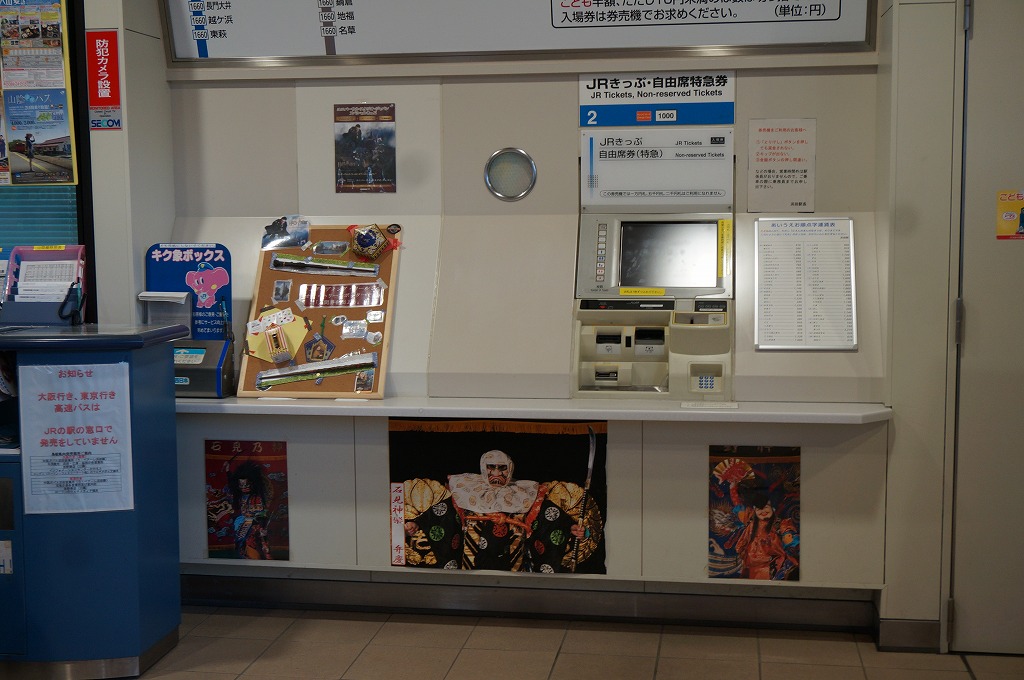




There is a book in which the author, like me, visited Iwami Kagura and wrote about his surprise. The description begins with a visit to see the New Year’s Eve kagura. He says “I wondered if there was really such a thing as going to see a kagura performance on the most emotional night of the year”. TV programs are also putting a lot of effort into this. Not so much anymore, but there used to be a singing program with a viewership rating of over 80%. There are also preparations to welcome the New Year. They may even choose to take their friends to watch the New Year’s Eve events. And yet, it’s kagura! The author writes “The old man said, ‘My grandchildren bring me here.’ It’s not the parents or grandparents who are making them watch traditional arts. It is the children who pull the parents in. How is that possible? I wondered”. The author of this website report had the same question. I wondered if people would willingly go to see such an old-fashioned art form as Kagura, no matter how popular it was. Young people, too.
Kagura starts around eight o’clock in the evening. I left the hotel hoping to make it in time. There is only one train an hour in this area. There was a little trouble here. It seems that I mistook the weekday and holiday timetables, and when I arrived at the station, I was already just in time. A station attendant told me this. “There was already a train on the other side of the station. Please hurry up.” I hurried to the other side of the platform. The driver was standing at the front of the car. He seemed to have been waiting for me. By the way, I saw a station attendant at the ticket gate making some kind of phone call. This is completely unthinkable in the city. I even felt as if eight million deities were guiding me.
It was dark in front of the destination station, unlike in the city. There were two cabs parked in front of the station. I had brought my bicycle with me at the time, so I took it. The 20-minute ride was dark. I wondered if they were really doing it. These questions kept popping into my head. Finally, I found a light. It was on! That was my honest first impression.
Kagura~ prologue
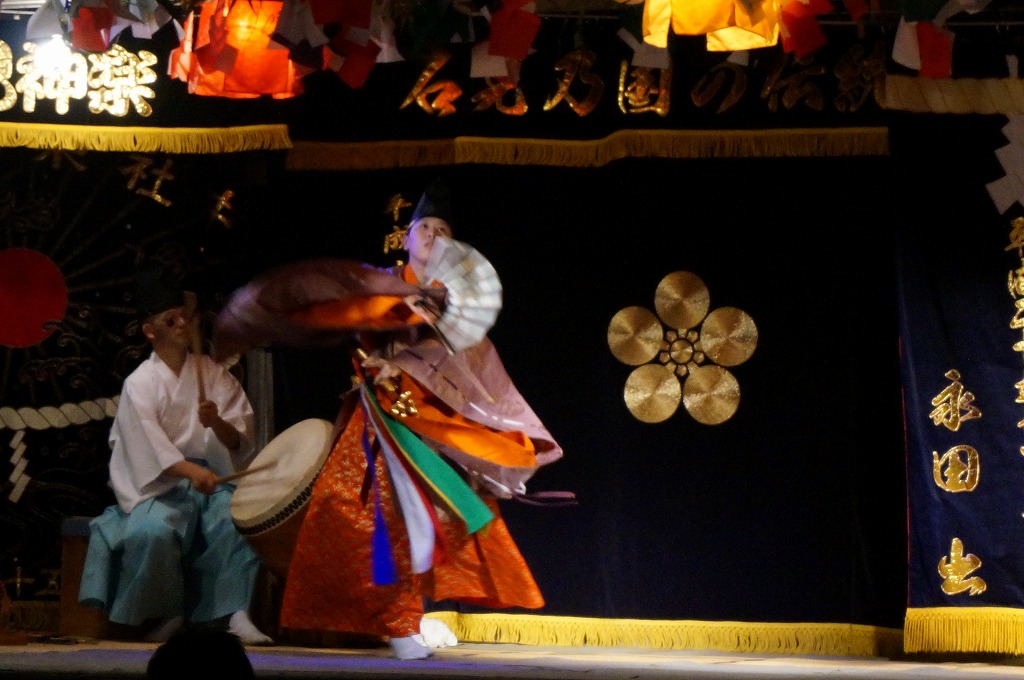

The time was 8:30 in the evening. The first performance had begun on the stage. The stage was a flat roof. (Although I found out it in the morning) the roof was made of red-colored Sekishu 石州 tiles (Sekishu means Iwami region), which are unique to this region. The lighting was simple, just a few bare bulbs hanging from the roof. There were also a number of paper decorations hanging from the ceiling. This is a common sight in authentic Kagura. They are called “Gohei,” which means “the papers which deities dwell” in Japanese. The light from the bulbs made them shine brightly, giving them a more luxurious impression than I had imagined. In front of the building (Kaguraden) is a large area with a small harbor on the other side and the ocean nearby. There were already people in front of the building on their knees on sheets spread out. Behind them are people with small chairs that look like director’s chairs. At the very back are six or seven people with tripods. Perhaps it was because of the early hour, but at this point it was not yet full. But as the performance progressed, more and more people came.
The first dance is called “Kamimukae (invoke deities)”. The first thing to do is to let the deities come down to this place. As a substitute for deities, countless ornaments are hung from the ceiling. Although it was a ritualistic dance to welcome the deities, it was not a leisurely one. It is a dance that involves intense rotation. A single male dancer with a gohei followed. Another dance by four men followed. The meaning of this dance is that the deities of the four directions, east, west, north and south, will bring peace to the earth. At the beginning, a woman’s voice gave us an explanation.
The Beginning of Entertainment “Hachiman”八幡
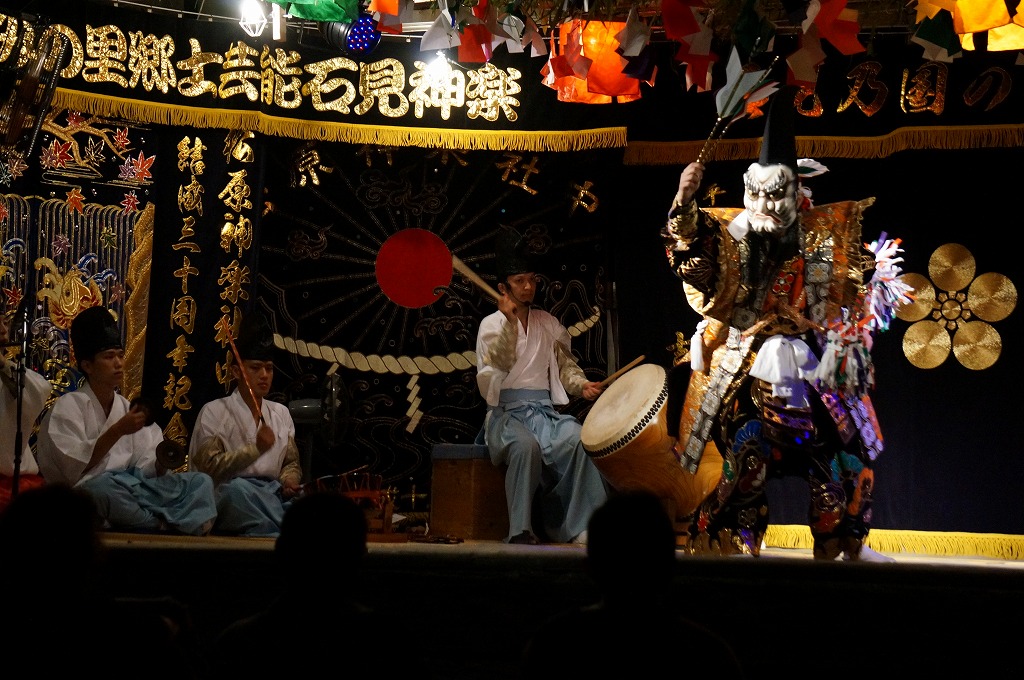
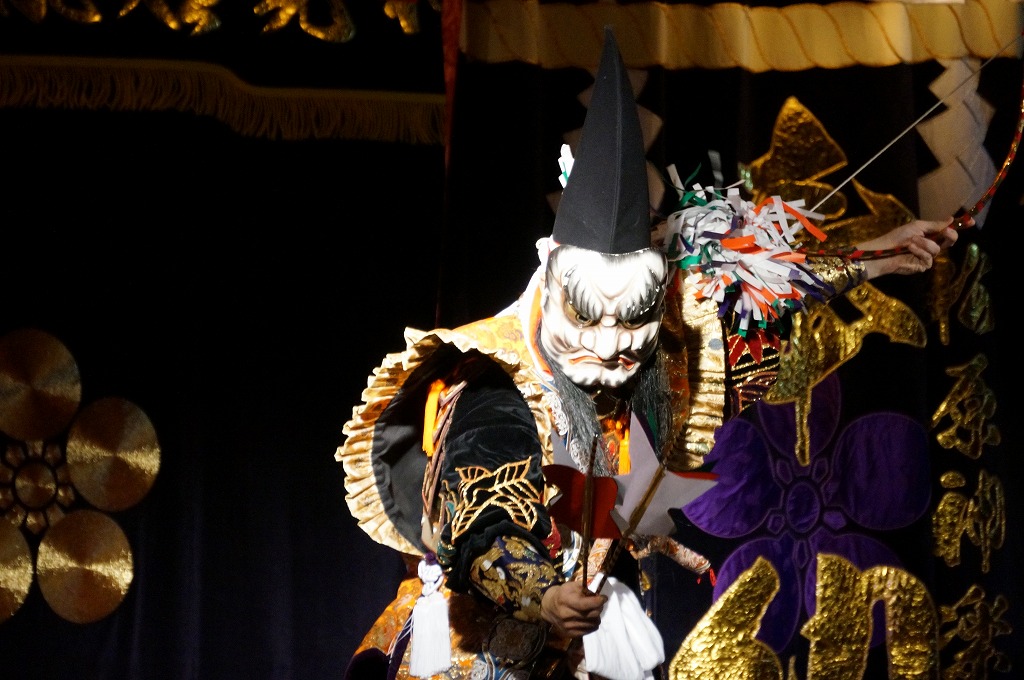
When they were done, it was already 9:30 pm. The number of spectators had increased considerably. The next performance was “Hachiman“. This is where the real entertainment with masks begins. The locals knew exactly what they were doing, and by this time the square was almost full. Here’s a brief look at Iwami Kagura’s specially based battles with gods, heroes and demons. Most of them are simply good and evil. The demons are just like demons, and they keep their evilness. So basically, if you watch it and you don’t know the characters, you won’t feel much discomfort.
The Hachiman in the title refers to the Hachiman deity, which is said to be the second most worshipped shrine in Japan after Inari. The most famous shrine dedicated to Hachiman is Usa Hachiman Shrine in Kyushu. In ancient times, around the eighth century, the oracle of Usa Hachiman thwarted the ambition of someone who wanted to usurp the emperor’s throne. Since the Middle Ages, the shrine has attracted the faith of samurai warriors and spread throughout the country.
The first part of the ceremony begins with the appearance of the Hachiman deity, who makes a speech (self-introduction). He is dressed in a flamboyant costume, just like the rumors. The masks are also large and powerful. The dance was graceful at first, and then became faster and faster. Just as they were finishing up, a mysterious smoke billowed out from the wing of the stage. This is another characteristic of Iwami Kagura, where a smoke screen always appears when the bad guys come out. When the smoke screen appears, you can be sure that this is the signal for the appearance of the bad guys. The lighting also changes to a slightly dark and suspicious color. And this time, from the beginning to the spark. This is also unique to Iwami Kagura, and they use fire without hesitation even though they are in a shrine. Fireworks are placed in the mouths of the masks, and the performers manipulate them. Of course, the fireworks are designed not to catch fire.
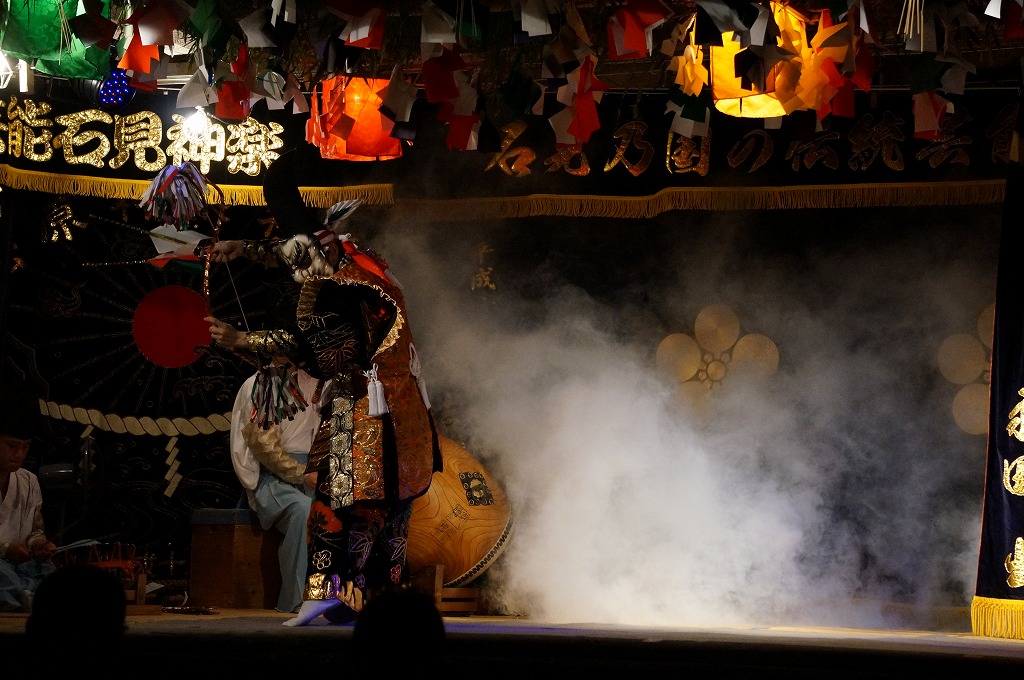
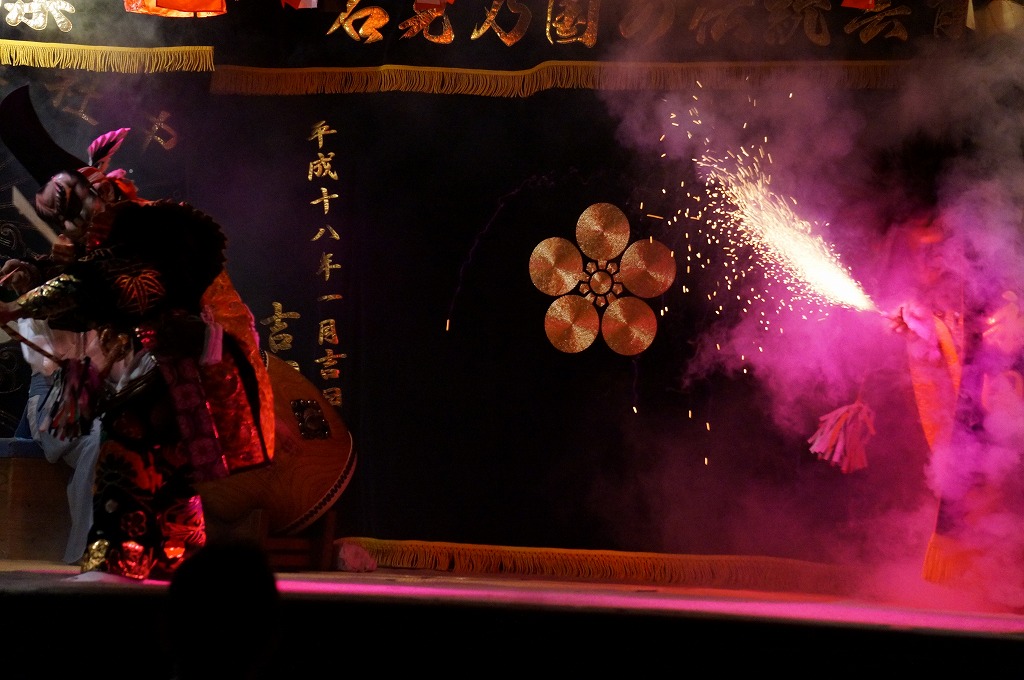
Hachiman casually withdrew from the stage once, and the demon king gave his speech. Here, he said, “I’m Dai rokuten Mao 第六天魔王 ( Demon King of the Final heaven of six desires)”. In Buddhism, there are six worlds of desire. In the sixth world of desire, which is the closest to the human world, the “Sixth Heavenly Demon King” presides over it. However, there is no need to know such a name at all. You just need to be able to recognize that he is a demon king who hinders the peace of people. He is simply a villain. And then, he says things that are typical of a villain in a dignified manner.
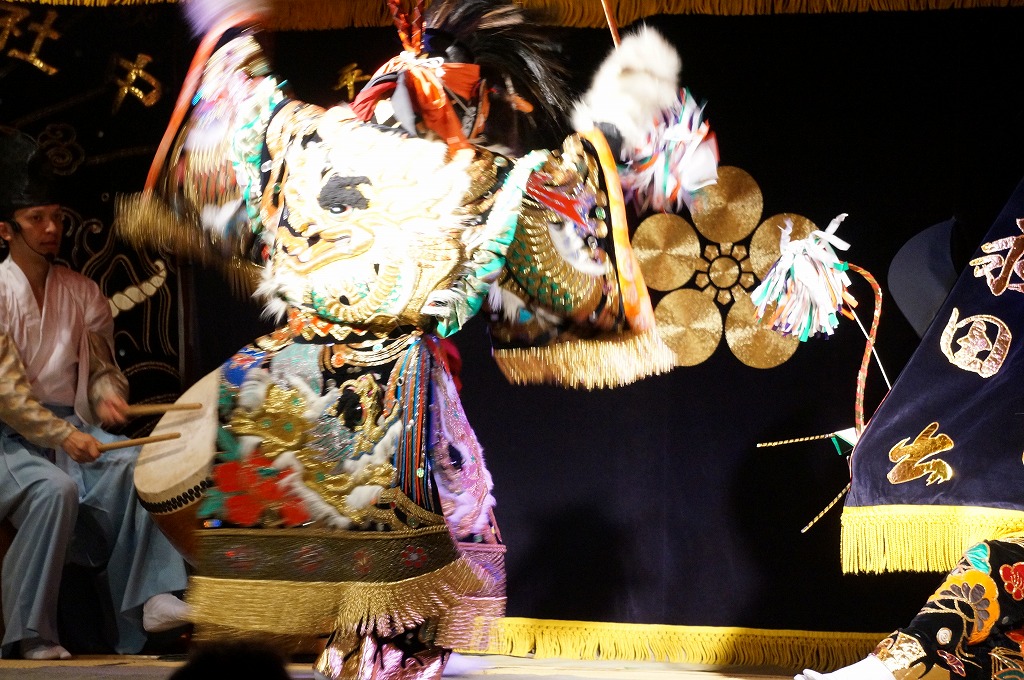
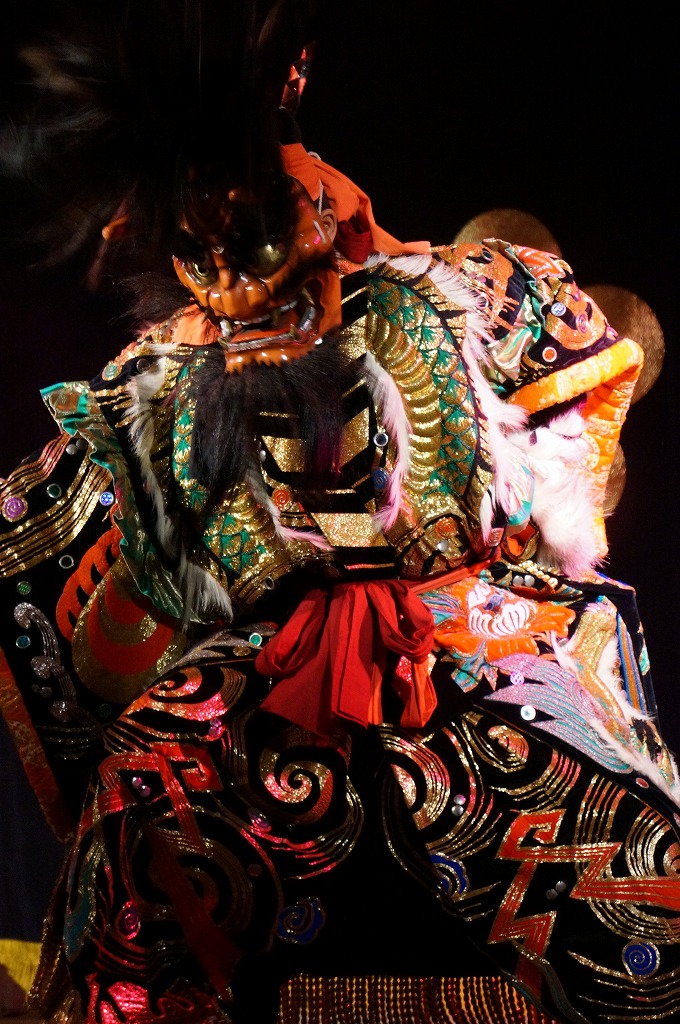
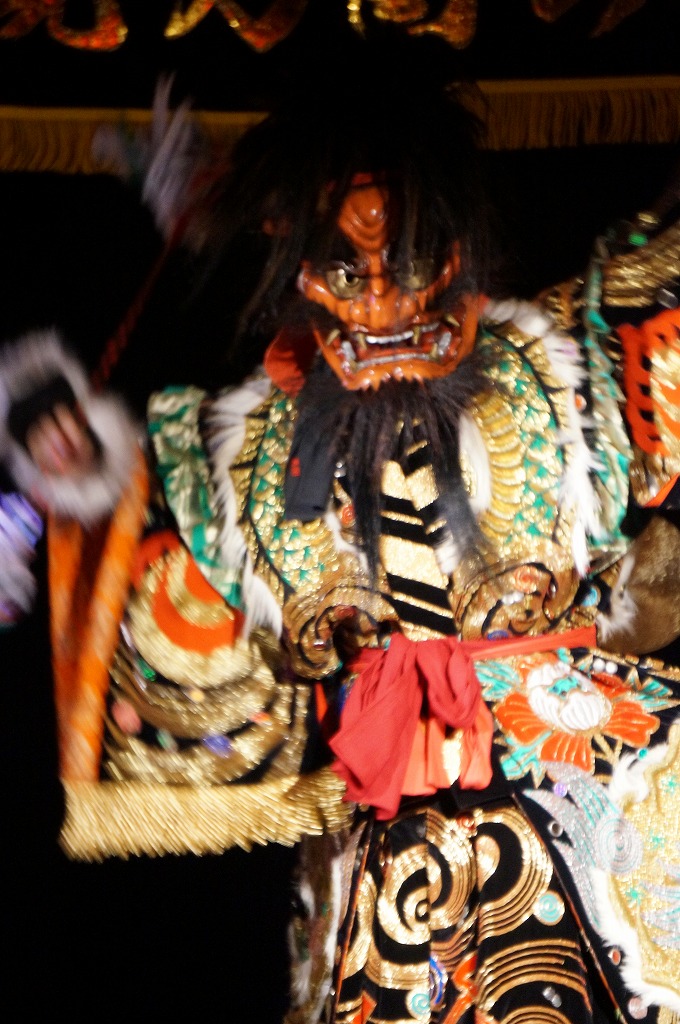
Hachiman pointed his bow and arrow at him and shouted. “Get out of here right now, and get out of this country.” Of course, the demon king would not back down with such threats and intimidation. Rather, it shows a power that seems to overwhelm Hachiman. If the villain is not strong, the main character will not be able to stand out. This kagura knows the basics of entertainment.
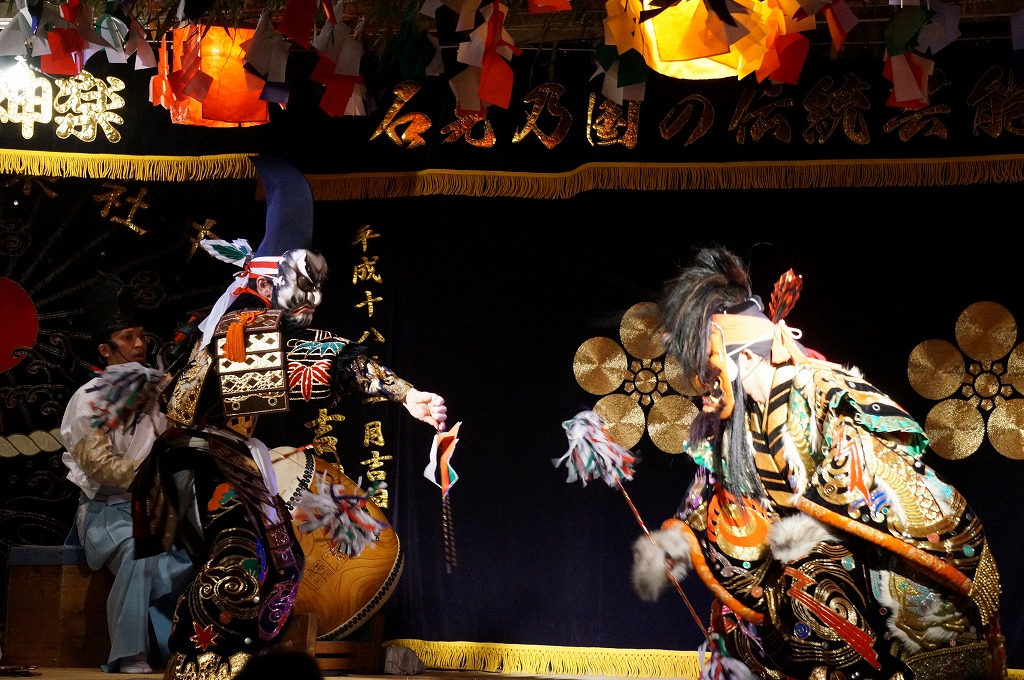
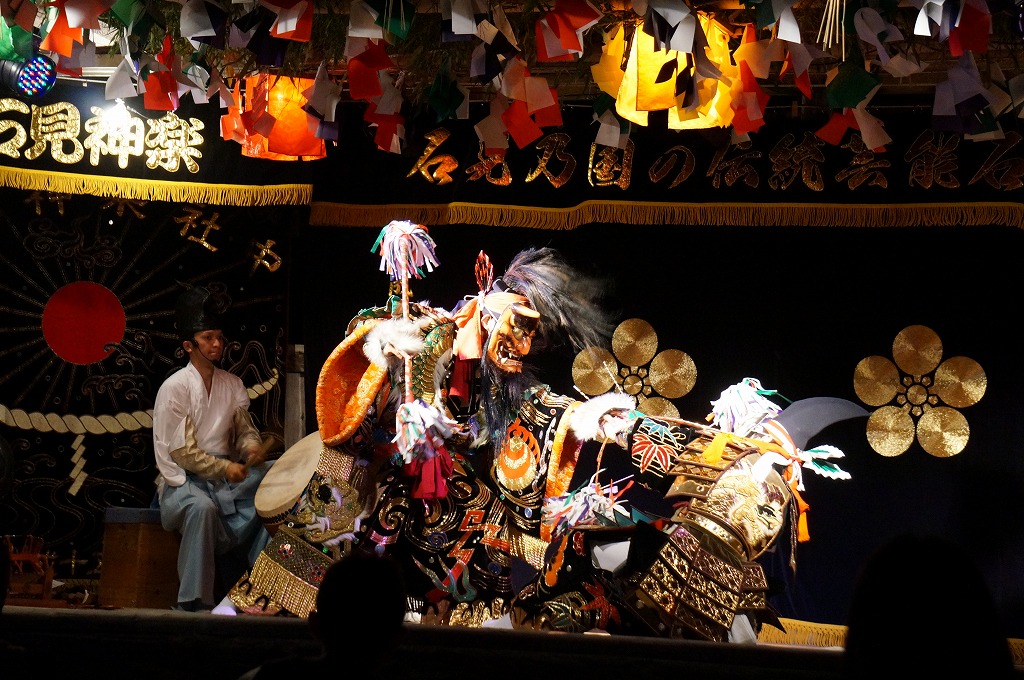
And finally, the villain falls. The demon king falls down with a cry of agony. But then…. From here, he comes back to life again. This is one of the characteristics of Iwami Kagura. The demon king is not so easily defeated. He’s a villain, but he has an admirable spirit. From there, the battle continues even more fiercely. There are many turns in the dance. They move their positions, turning around and around each other. It’s like a figure skater. I was amazed at how he was able to keep his eyes on the ground. The sense of speed. In addition, the taiko drummers were shouting “Eisa, Eisa” to the crowd. He was almost shouting himself hoarse and beating the drum as if he wanted to burst it. Kagura is originally based on the Omoto 大元 Kagura. This Omoto Kagura is based on a slow musical style called six tones. However, when it became Iwami Kagura, the rhythm changed to a faster rhythm called eight tones. This aroused the excitement of the audience more and more. All of this was amplified by the huge speakers set up in the back. The volume was so loud that it almost damaged my ears. By this time, the venue was pretty full. It’s a quiet fishing village where you can only hear frogs. It would be the same whether they were at home or at the venue if the sound echoed at such a loud volume. In other words, no one would complain about playing Kagura at such a high volume. This is proof that kagura has permeated this area.
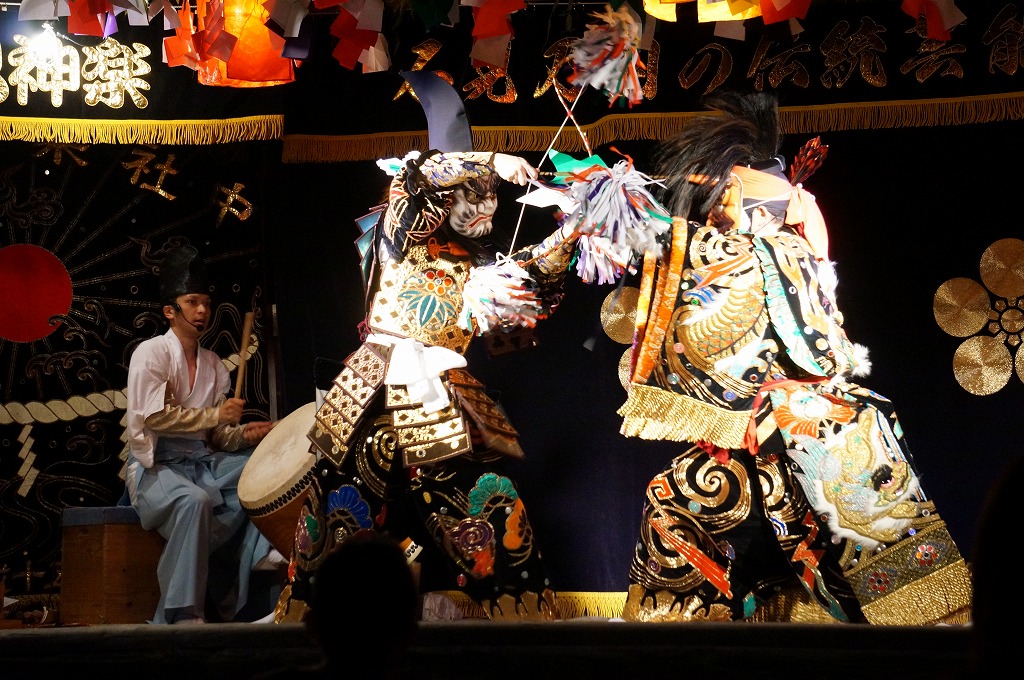
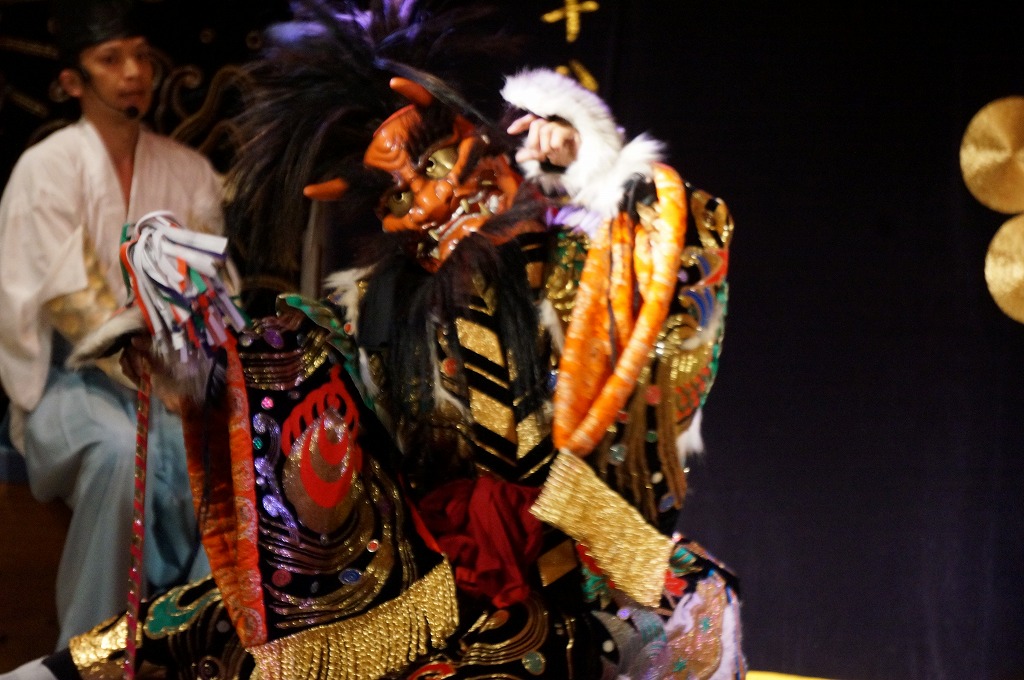
The Hachiman actor withdraws once, takes off his mask, and performs a dance as a final greeting. The villain does not take off the mask. This also seemed to be an expected way to end. It took about 30 minutes. It was still past ten o’clock in the evening.
Jimmu 神武

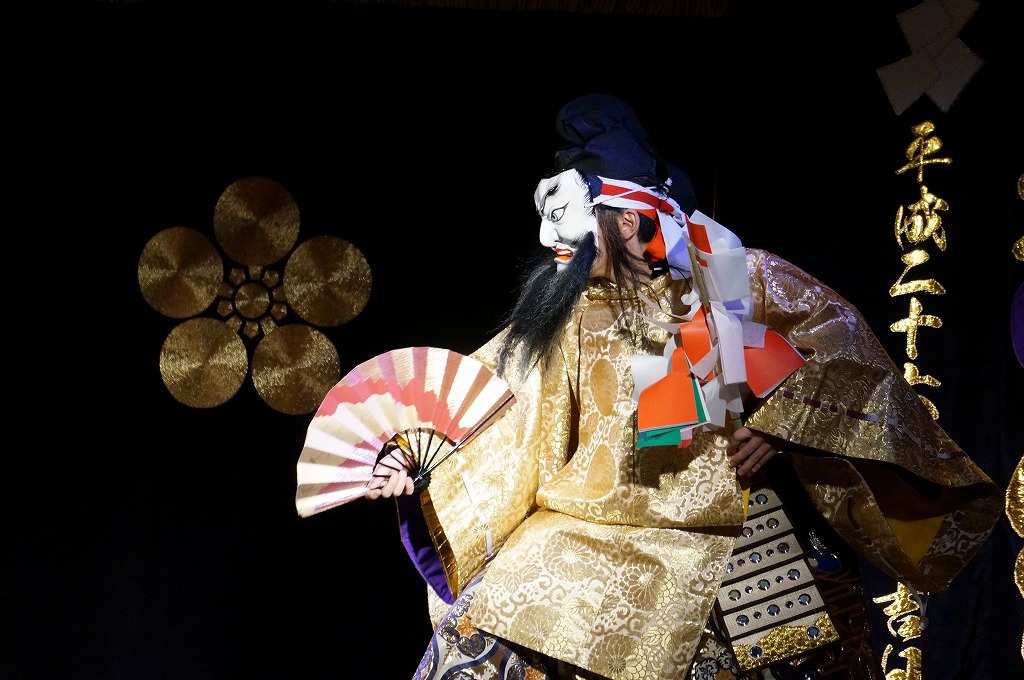
The next performance was called ” Jinmu”. This is based on a story in the oldest official Japanese history book. Jimmu is the name of the first emperor of Japan. He was born as the son of a god, but this is where the history book enters the world of man. He was in Kyushu for a long time, but one day he decided to go eastward. His destination was present-day Nara Prefecture. This is how the history book describes it. There was a tyrant named Nagasune-hiko, who was tormenting the people. Hearing rumors of this, Jimmu attacked and defeated them to bring peace to the land. This is where the foundation of the current imperial family was laid. From Nagasune-hiko’s point of view, Jinmu may be a mere invader, but history is only depicted from the victor’s side. And in the entertainment of kagura, the pros and cons are irrelevant. In short, it is just a symbol that there are good ones and bad ones.
First of all, Jinmu and his attendants appeared and introduced themselves and danced. In the middle of the performance, two demons appeared, creating a suspicious atmosphere. This is Nagasune-hiko and his men. This is a form of two gods and two demons, which you can often see in Iwami Kagura. Once again, a fierce dance ensues. The four of them fought each other with their swords, spinning around like a frame. Performance while wearing masks, heavy costumes and with fierce movements, was quite exhausting. When they returned to the dressing room, they were out of breath. Eventually, they defeat one of the enemies, but the leader still fights. I can’t help but admire the feats of the enemy. However, in spite of his efforts, he meets his end as if a huge tree is cut down from the roots and collapses.
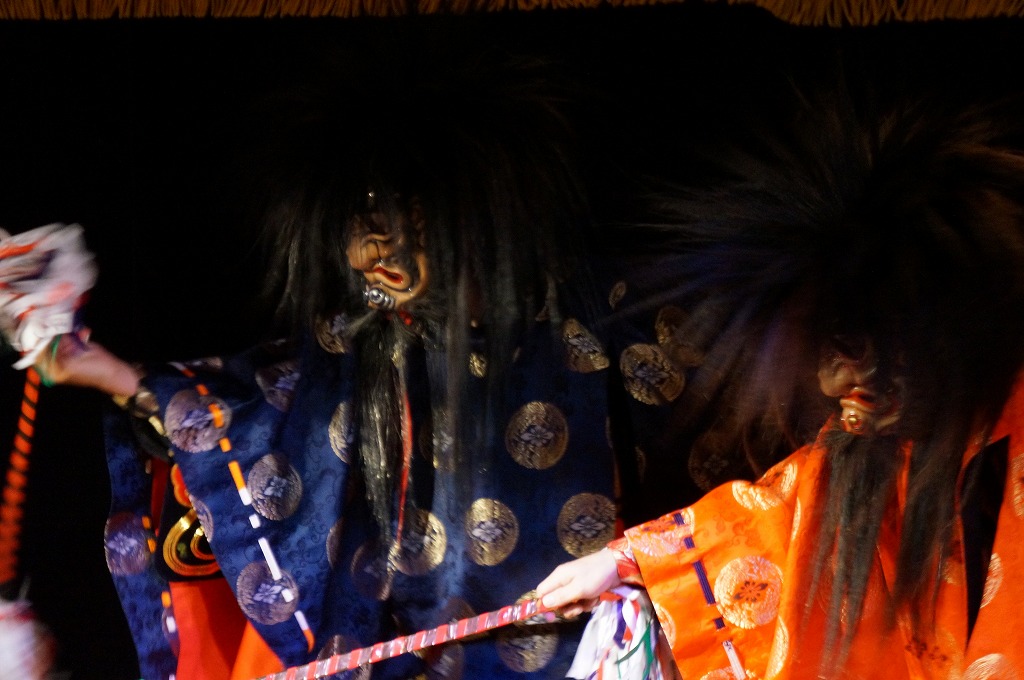
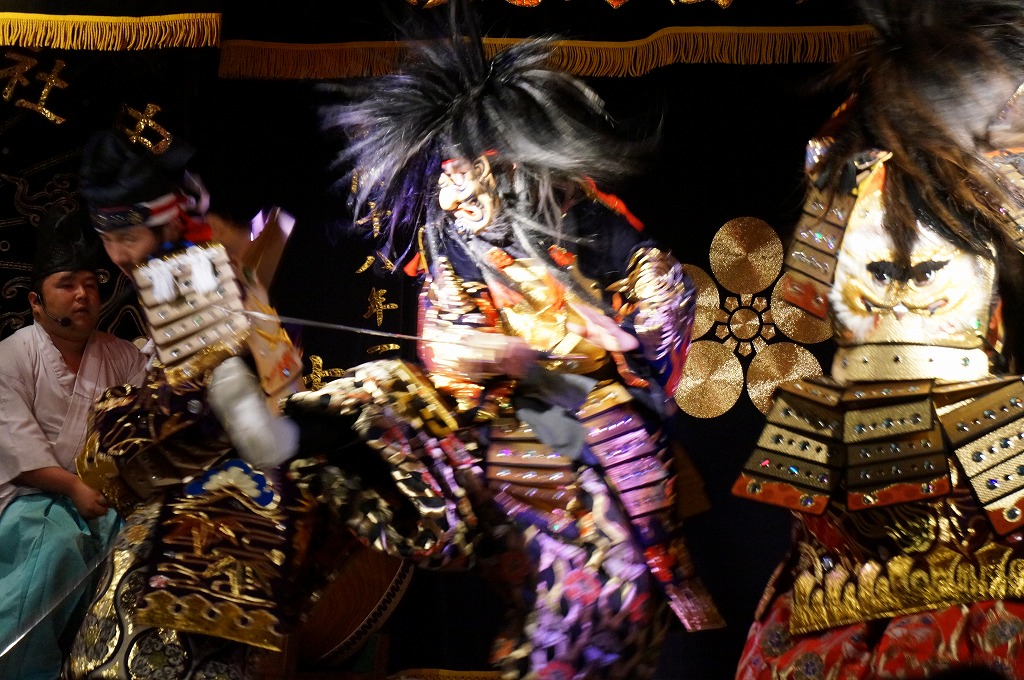
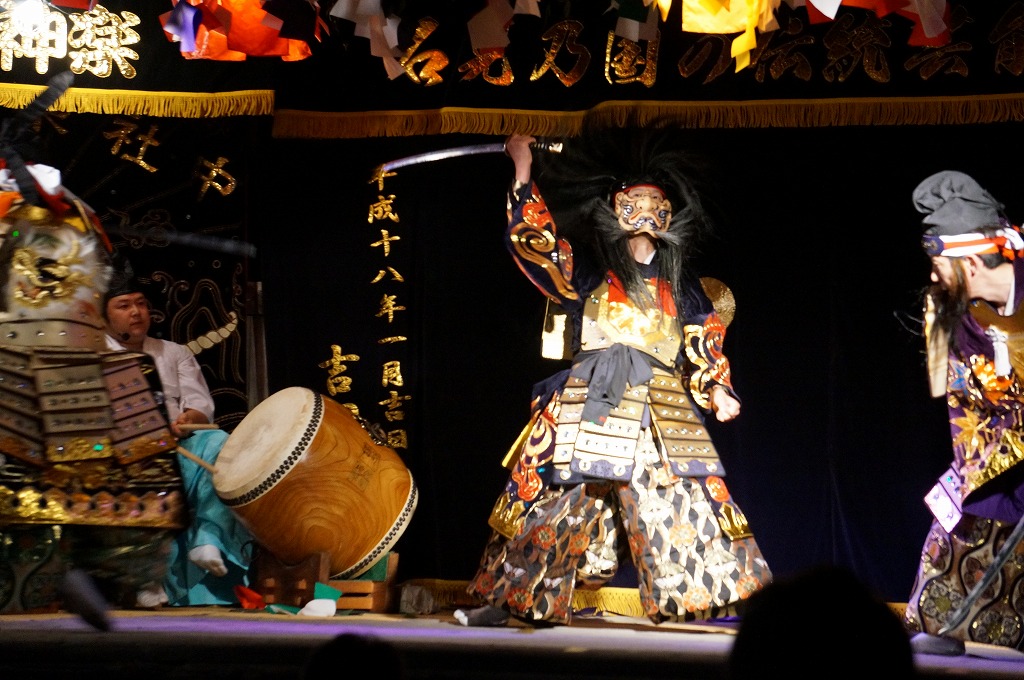
Thanks for the gifts of money-御花御礼

At the end of each act, there is an “on hana onrei”. To put it simply, there is a time to thank the people who donated money. This is also a beautiful, flowing speech.
I wanted to hear this, so I visited the backstage in between. The dressing room was a simple structure with a curtain stretched across the side of the Kagura-cottage. Costumes were lined up in rows, and actors sat on chairs as if they were struggling to breathe after finishing their roles. Inside, people were working hurriedly. It was like a field hospital.
I don’t care how much onrei you have, and there is no need for anything special. All you have to do is hand the money to the person in charge. When the next performance was over, your name would be called. If they read out your name, it will be an unforgettable reminder
to be continued Part 2
Yamato Takeru 日本武尊
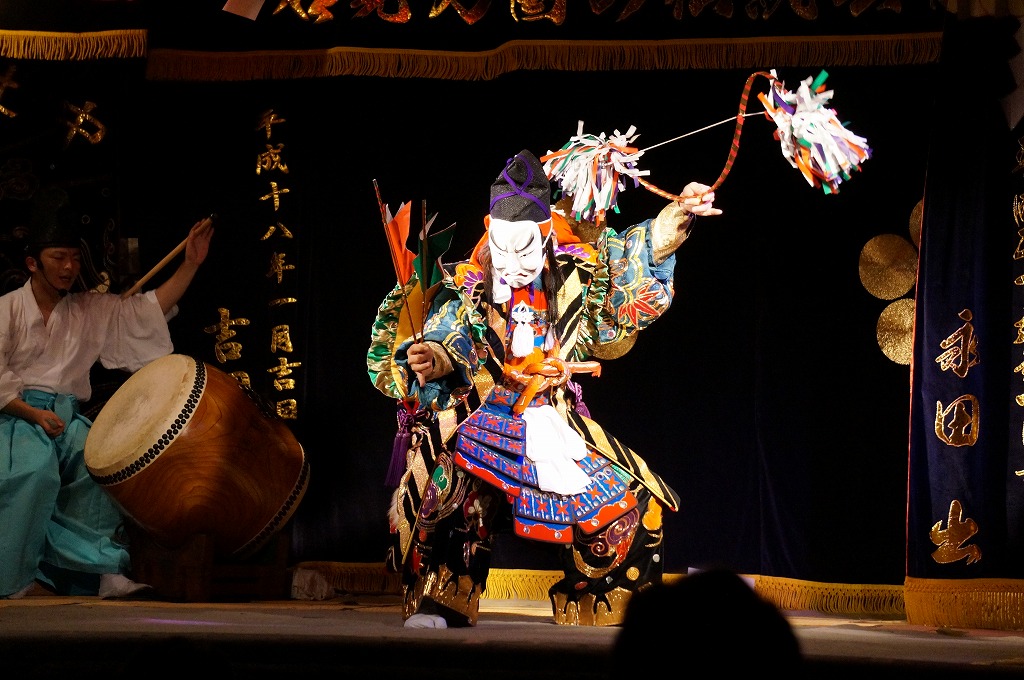
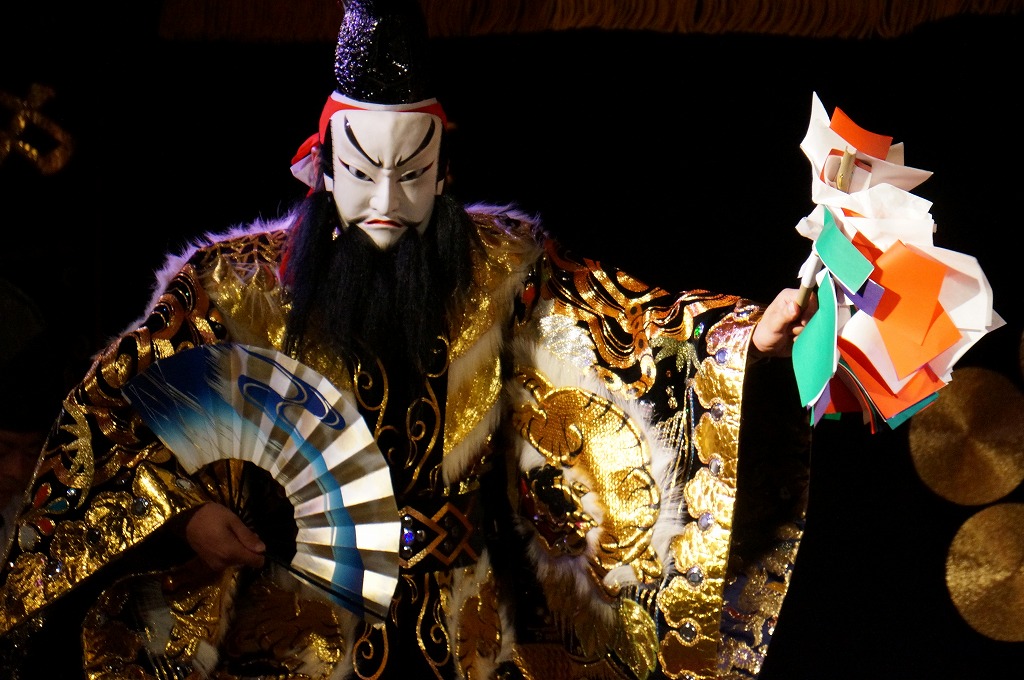
At this point, it was around eleven in the evening.
Yamato Takeru is a real person, a hero who fought in various places on the orders of his father the Emperor. On the other hand, he is also a tragic hero who was shunned by his father the Emperor for his good performance and spent his whole life roaming through the country. The story is based on a famous episode in which he survived a fire attack by his enemies.
The story begins as usual with the appearance of Yamato Takeru and his subordinate, Kibitsuhiko, in a dance. It was so beautiful that it looked as if a puppet had jumped out and moved.
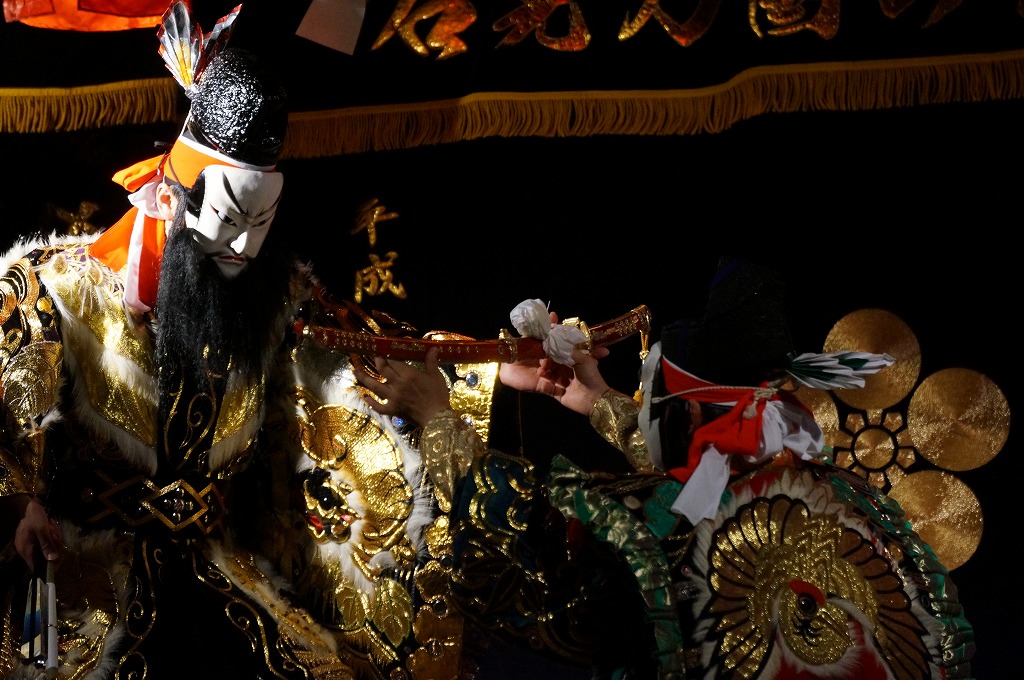
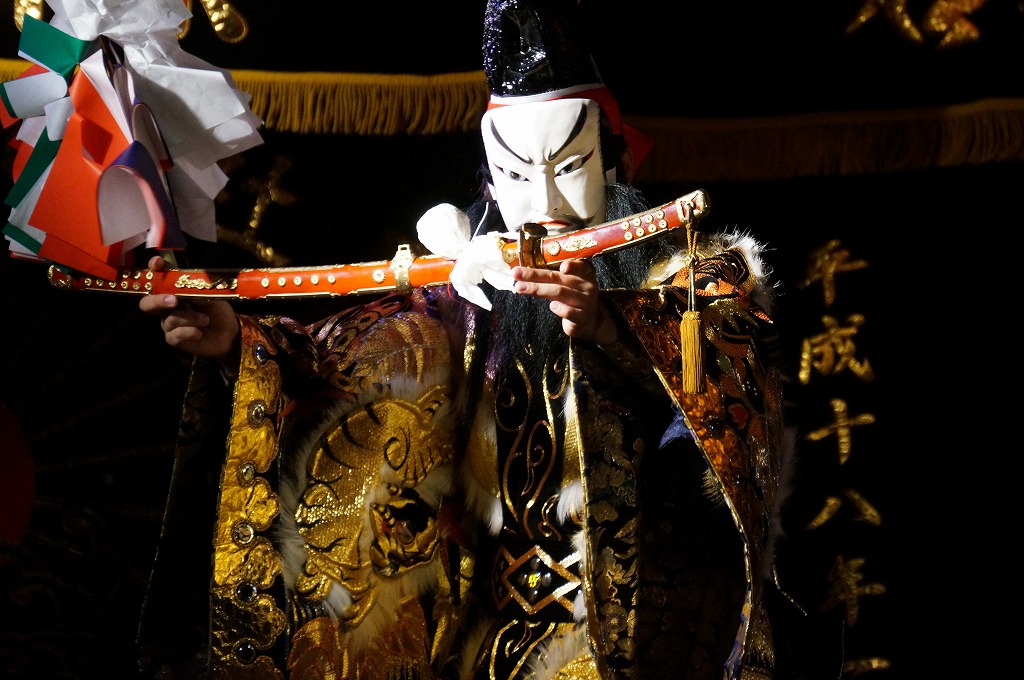

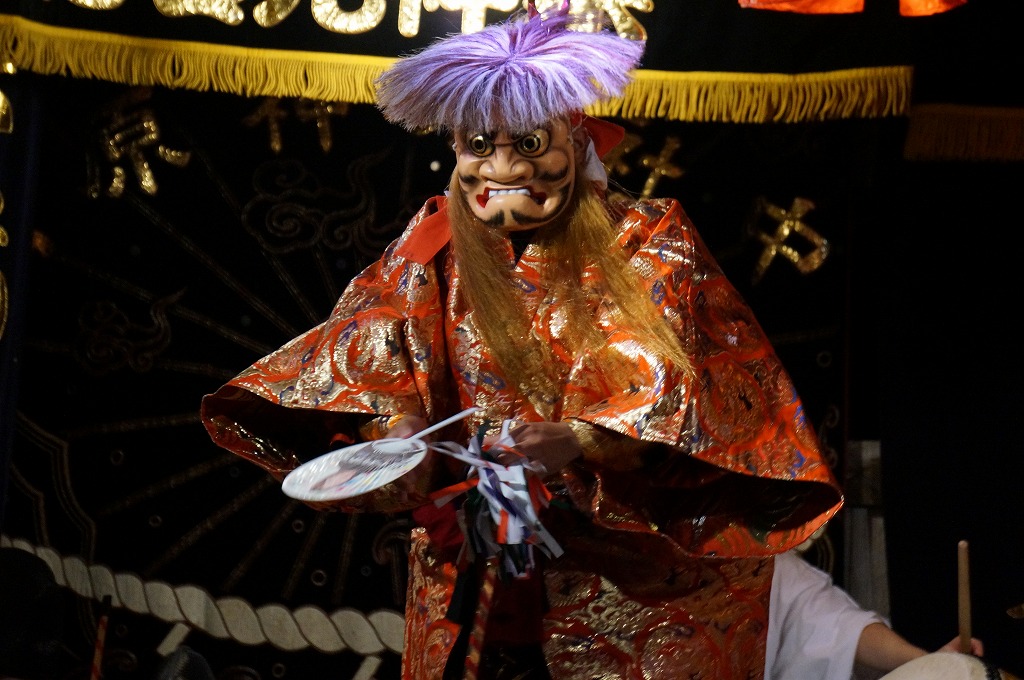
Once they retracted, the enemy brothers now appeared. But here, things change a bit. Normally, they would perform a dance, say a few words, and then get into a battle with the heroes. But here, when they appear, they engage in a dialogue with each other. They speak in the Shimane dialect of everyday life. “You’ve got a nice fan. Is it from the Tokuyama boat race?” “Yes”. ”Still, it’s pretty crowded today” ”I hear there’s fireworks.” I guess they know the audience wants to take a break from the good and bad stories that had been performed for two consecutive performances. A little ingenuity like this is necessary to continue a long performance.

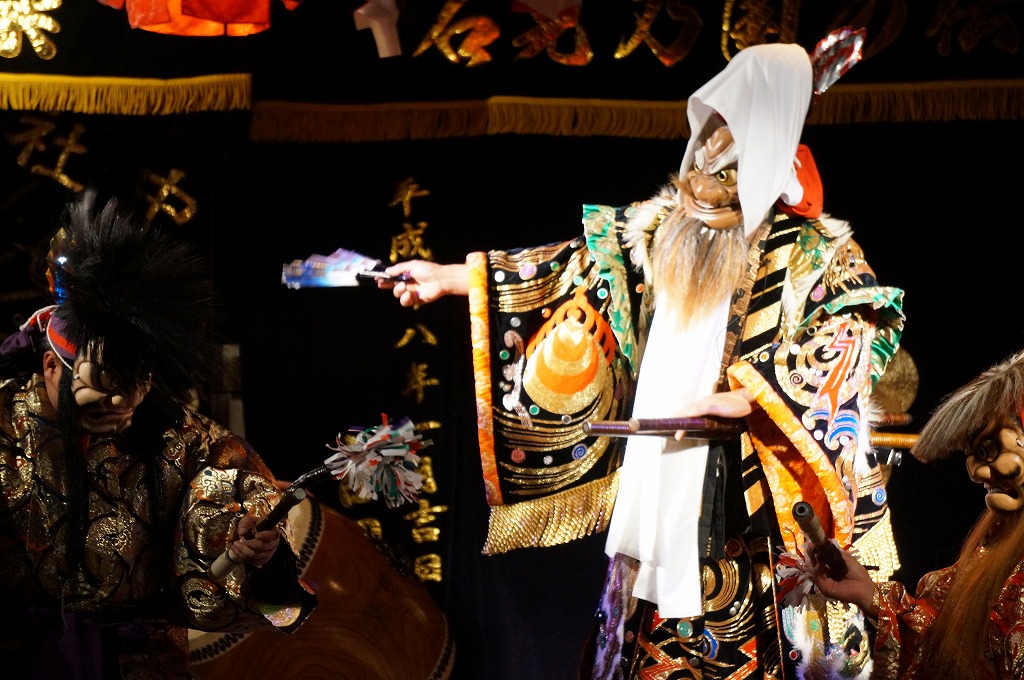
As they were making their plans to defeat Yamato Takeru, their master appeared. Again, he chatted with each other, saying things like, “He’s always been dark-skinned, so it doesn’t make any difference whether he wears a mask or not,” and “He’s excited because he’s a local.” The story goes on even during the comic break. How do we defeat Yamato Takeru? When they asked, the master gave them a plan: “You should set him on fire when he’s caught off guard.” The boss is actually a very wise man.
They then pretend to submit to Yamato Takeru and invite him to hunt deer. From here, a rather famous episode in mythology unfolds. It is a story like this. They lured Yamato Takeru out into the field and set fire to the grass around him, setting him on fire. At this time, Takeru uses a sword given to him by his aunt to knock down the surrounding grass and escape the predicament. For this reason, this sword came to be known as “the sword that cleaves the grass. And from here, another fierce battle dance ensues. The heroes were unmasked, but the villains kept their masks on. But as the battle becomes more intense, the villains finally take their masks off. I can only assume that this is how hard the exercise is.
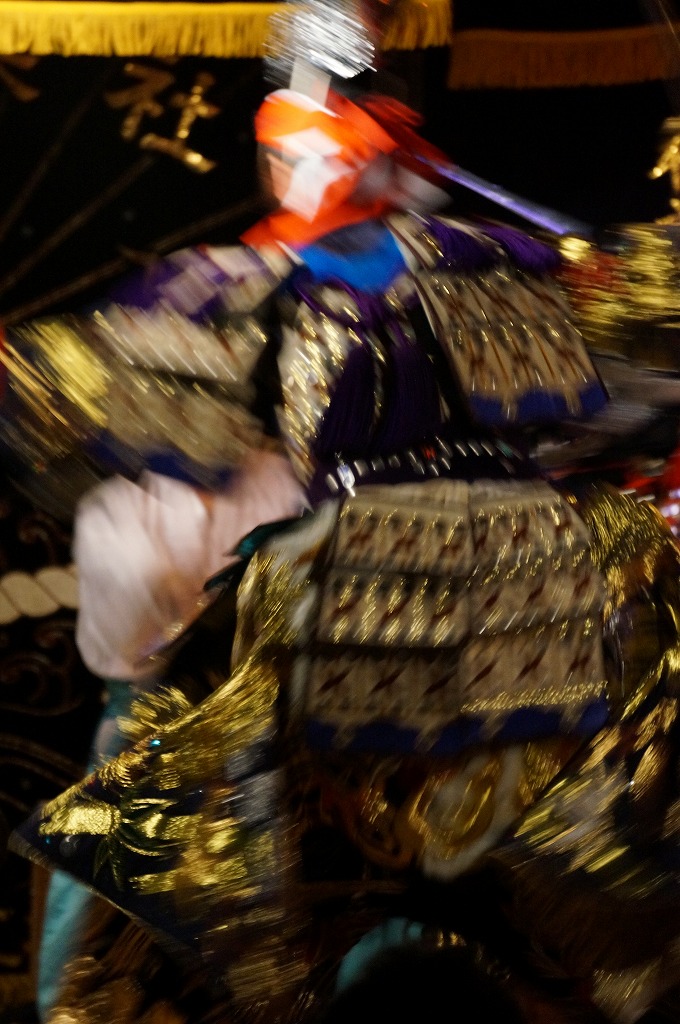
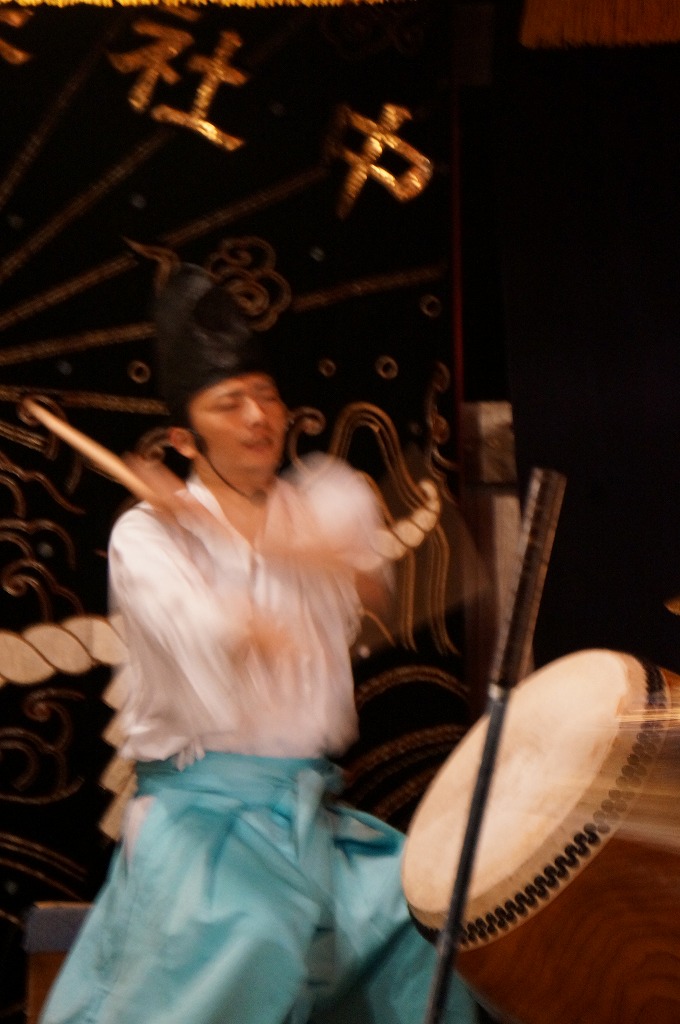
Ebisu 恵比寿
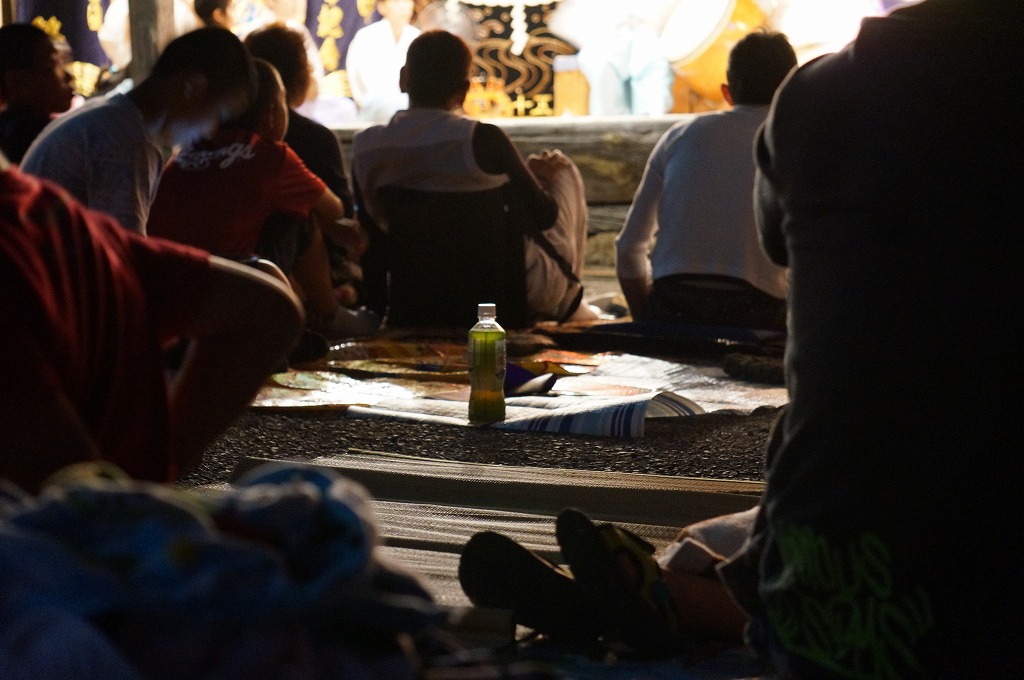
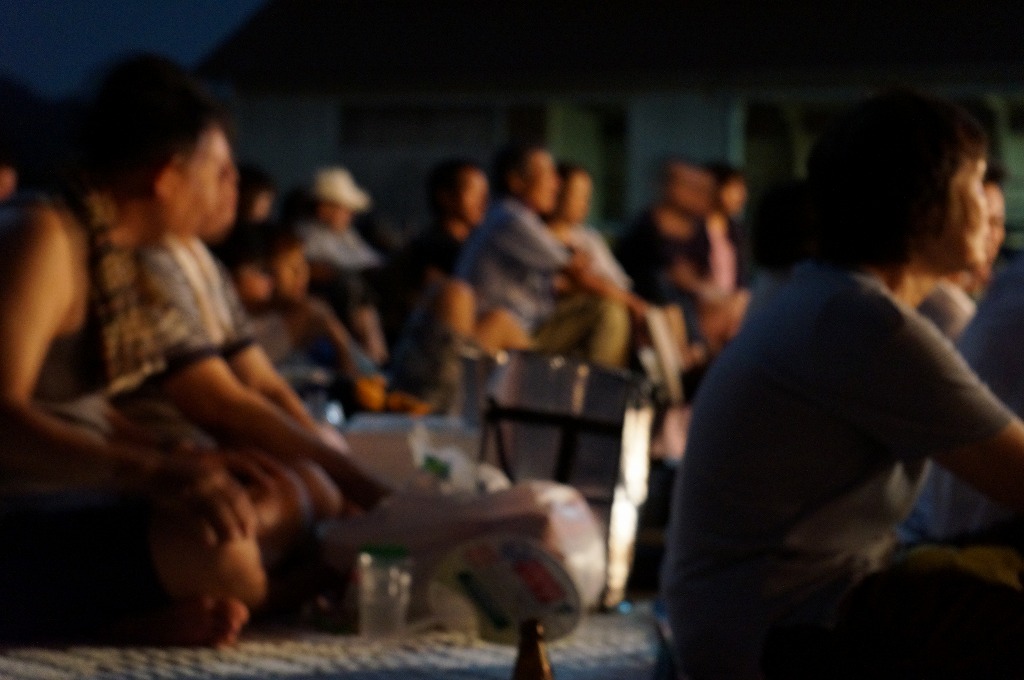
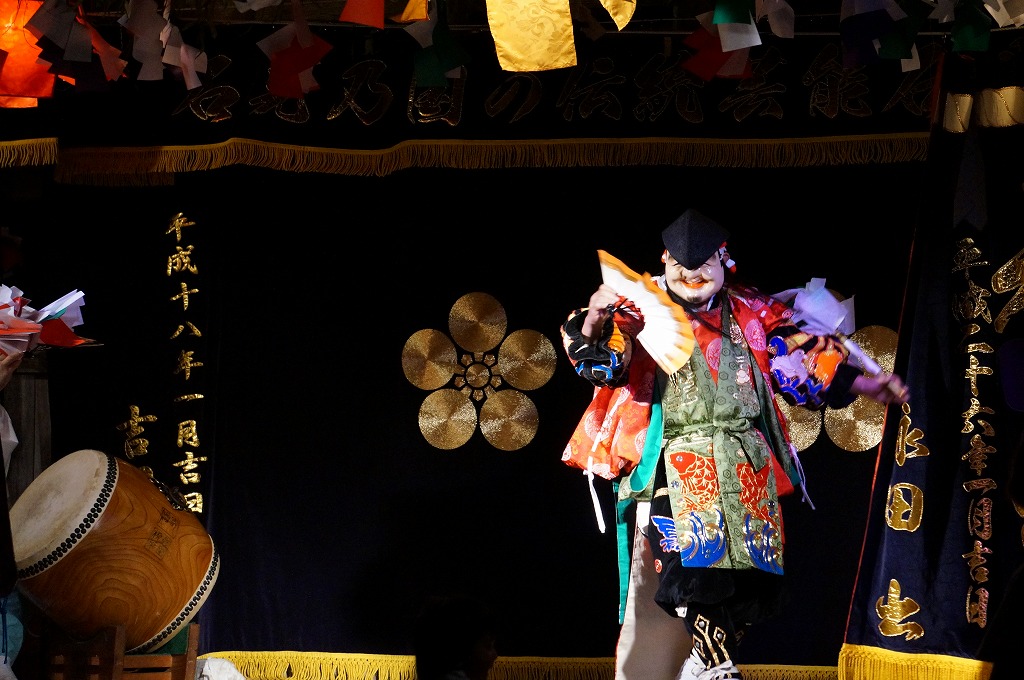
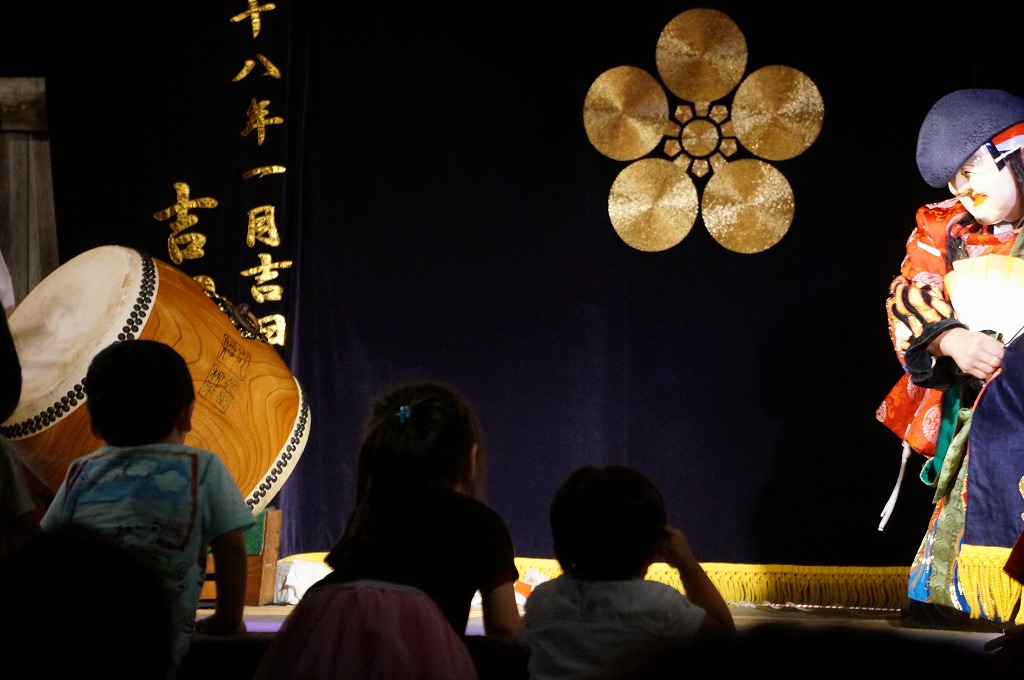
The time was already around midnight. People are starting to feel deeply sleepy. For some reason, children were coming up to the front. It was a festival, so it was not strange to see children awake at this time. Anyway, with such loud music, it would be the same if people were at home. It would be safer to stay at the venue, since the whole family was out there. Anyway, why?
The answer to that question is quite simple. It was Ebisu.
People are familiar with Ebisu and its kagura. In Japan, there is the so-called Seven Deities of Good Fortune. Shichifukujin (“seven gods of good fortune”) are a group of gods from Japan, China and India, regardless of their origins, who bring good fortune to people. (For more information, see.→)And Ebisu is the first of them all. This is what people think of Ebisu. He is always smiling, wears a crow’s hat, and holds a fishing rod to catch sea bream. Yes, the Kagura troupe has come up with a performance that is not about good and evil. The fact that we can see these innovations without getting bored is a result of the long, night-long performances.
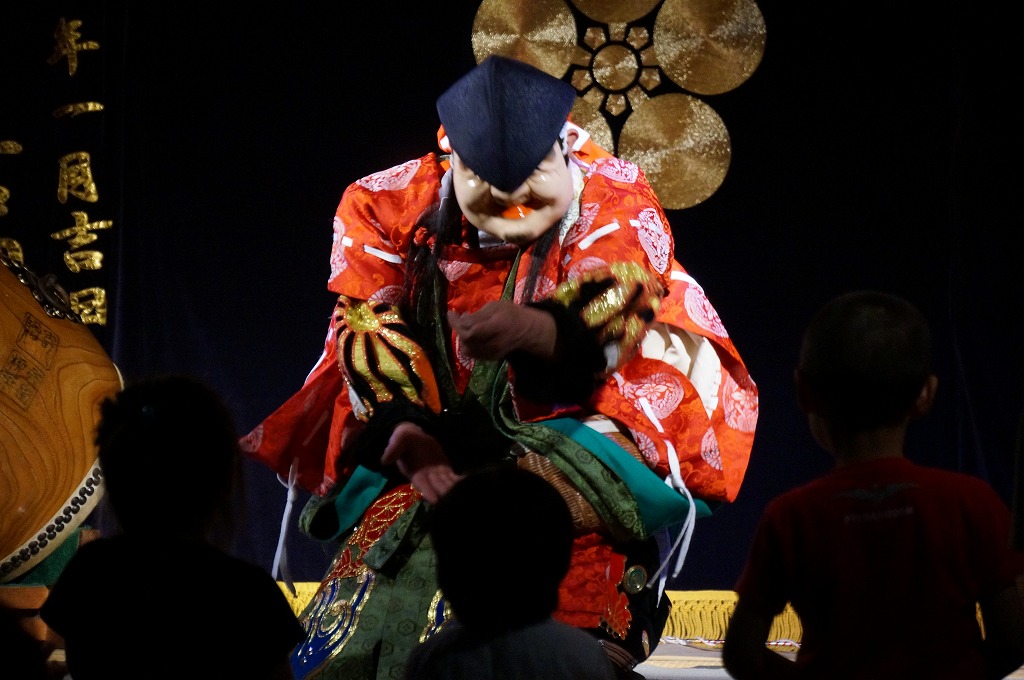
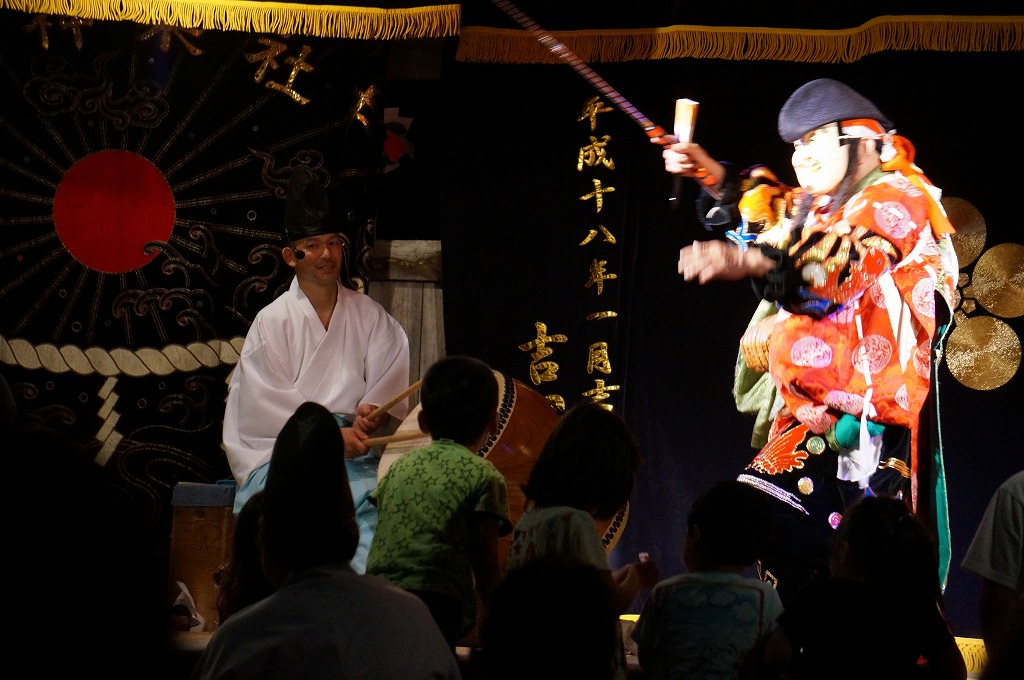
Ebisu catches a sea bream as expected. Whenever Ebisu throws a fishing line and the audience tugs at it, the audience responds beautifully. The audience’s response to the situation was superb, and you could sense that they understood the kagura very well. Ebisu took out more and more sweets from the fish basket hanging on his waist and distributed them. This was what the children were looking for. This program took about half an hour.
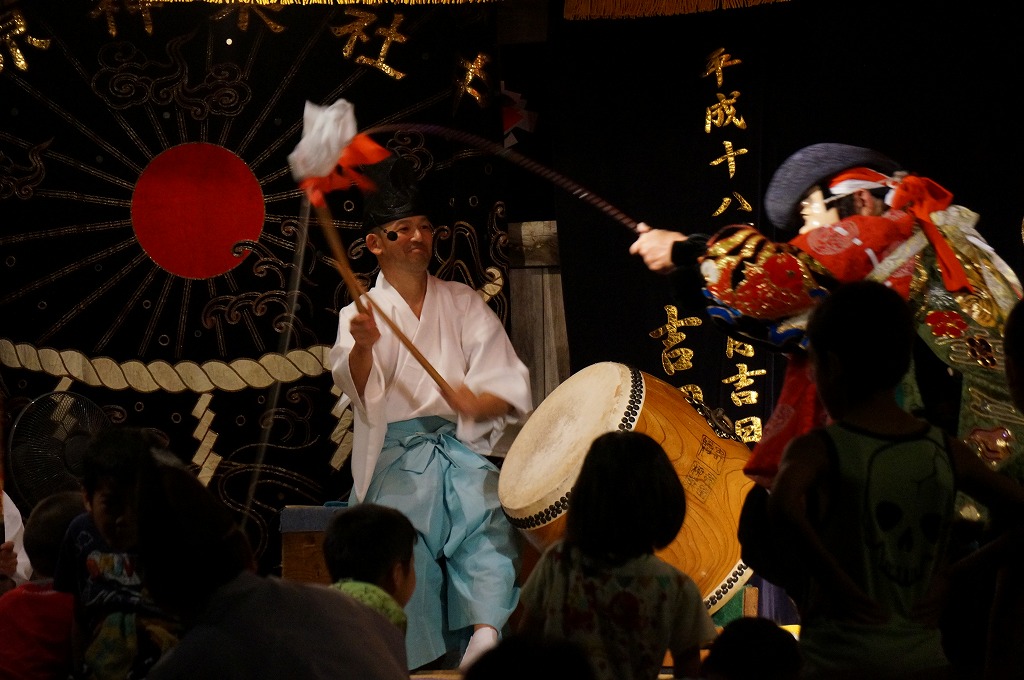
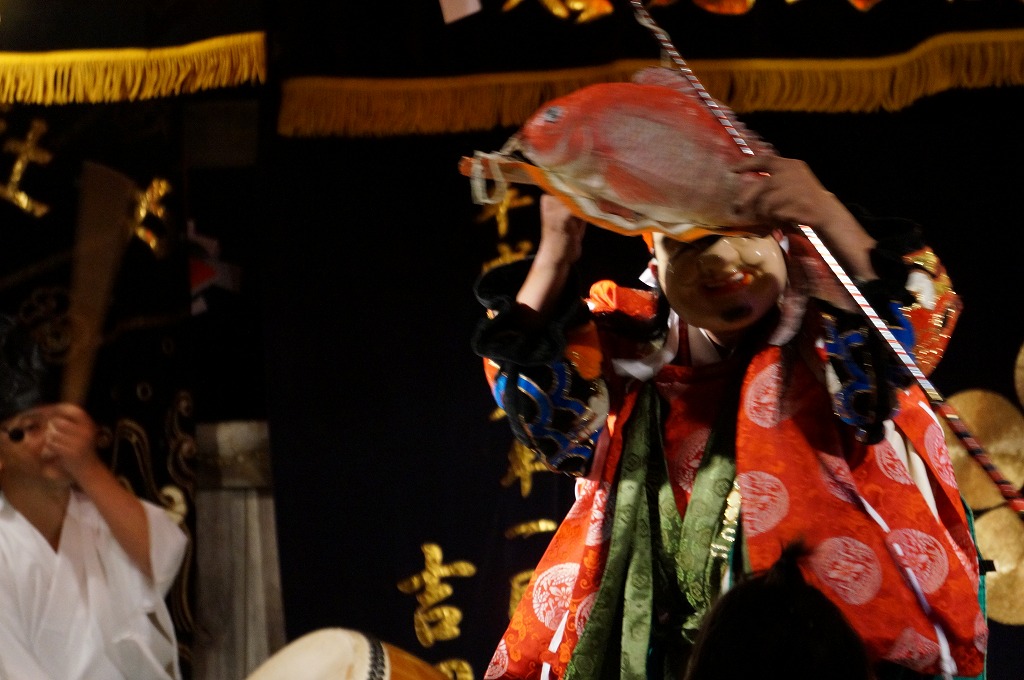
Tenjin 天神
Next, they return to the story of good and evil.
Tenjin is a famous god of learning in Japan. Kitano Tenmangu Shrine in Kyoto and Dazaifu Tenmangu Shrine in Fukuoka are famous. Dazaifu, for example, is such a popular shrine that they joke that people from all over Kyushu gather there for New Year’s visits.
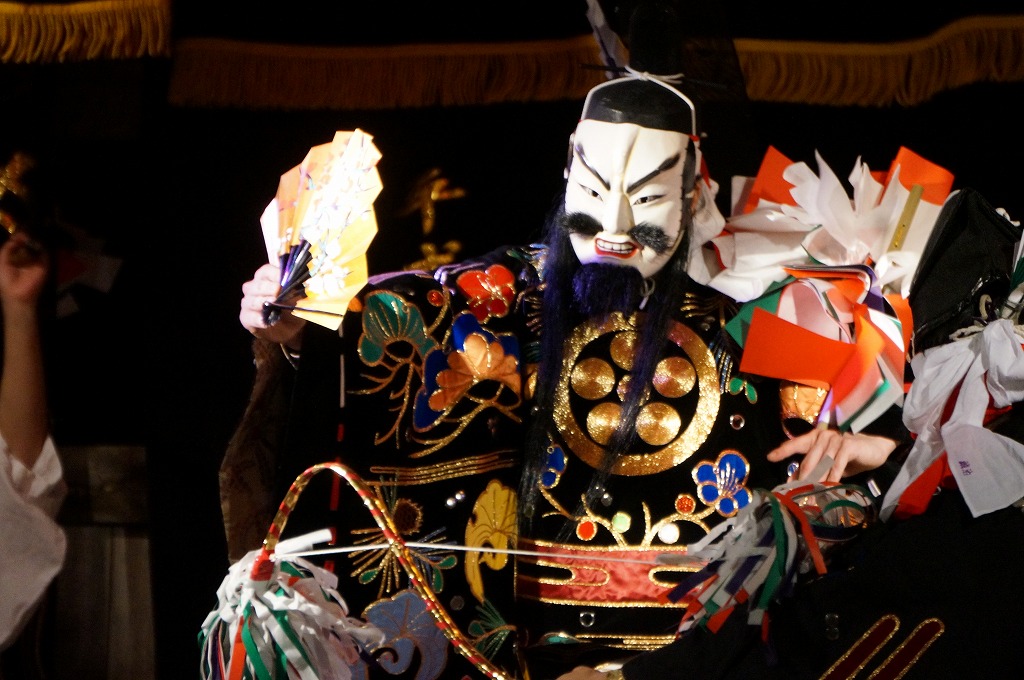

Tenjin was originally a real person named Sugawara Michizane 菅原道真, who was active in the late ninth century. He did not come from one of the mainstream political families of the time. However, because of his academic excellence, the emperor of the time loved him very much so Michizane could be promoted in the Imperial Court. On the other hand, he had policy conflicts with the Fujiwara clan, which was a major power, and they sent him to Kyushu. There he died in a fit of rage. After his death, a series of incidents took place at the Imperial Court. Lightning struck, sickness spread, and the supreme authority, Fujiwara no Tokihira 藤原時平, who was responsible for relegating Michizane, died of illness. The people feared that this was a tragedy caused by Michizane, and decided to worship him as a god.
In this program, they will directly confront each other, just like Kagura.
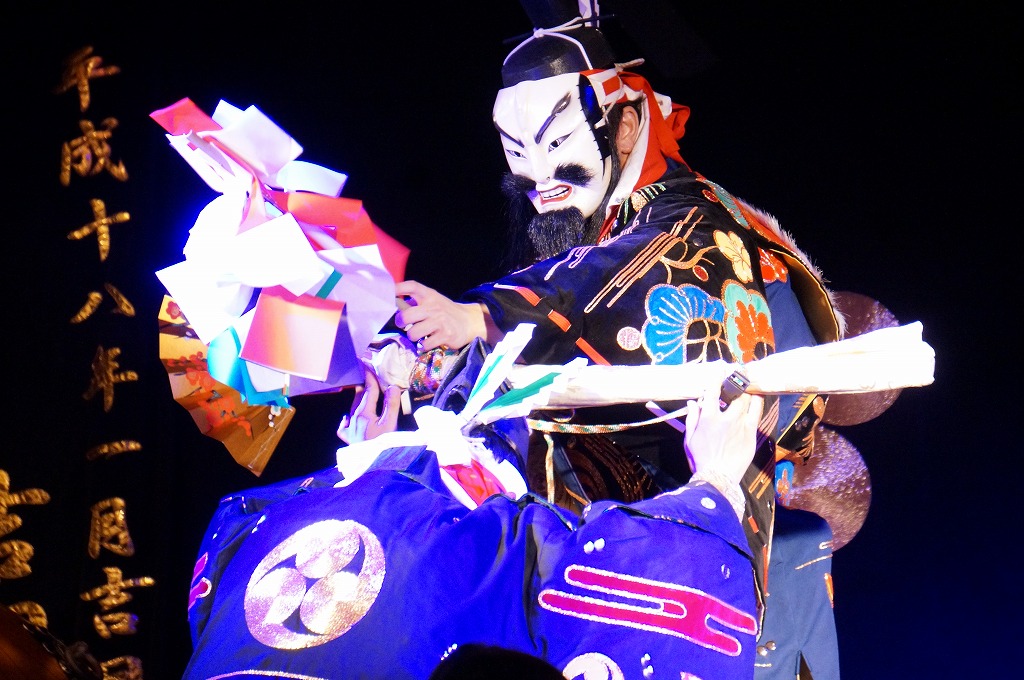
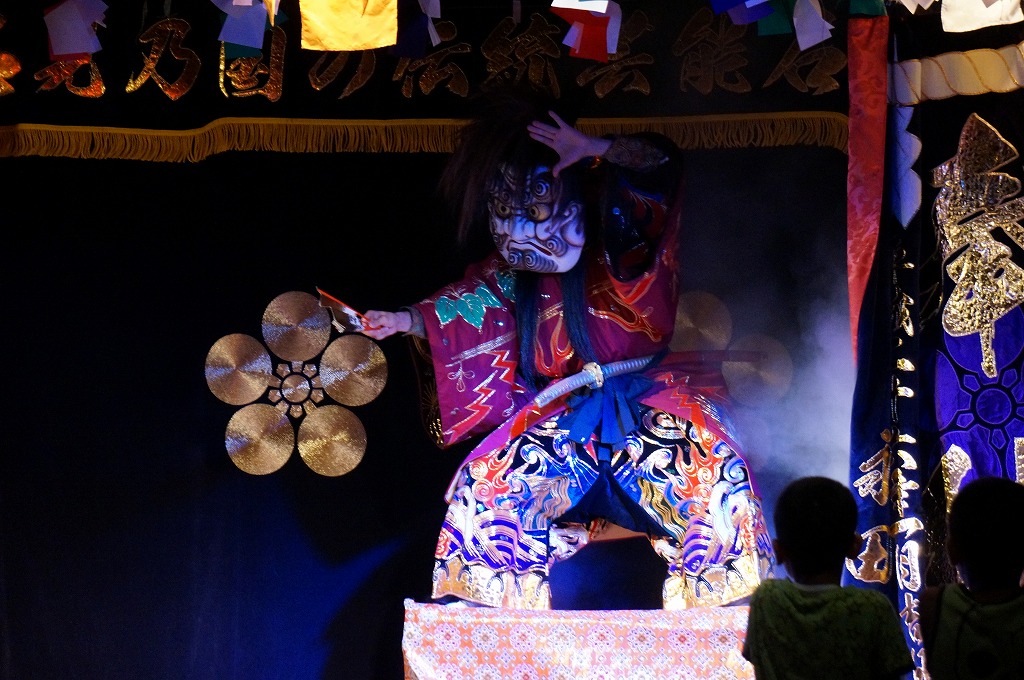


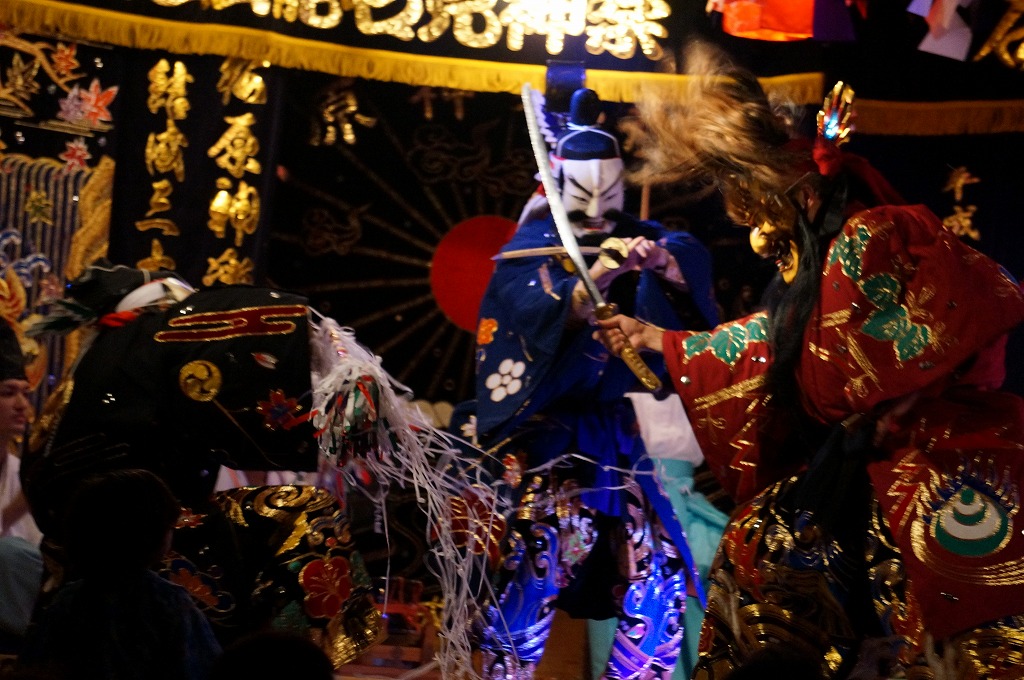
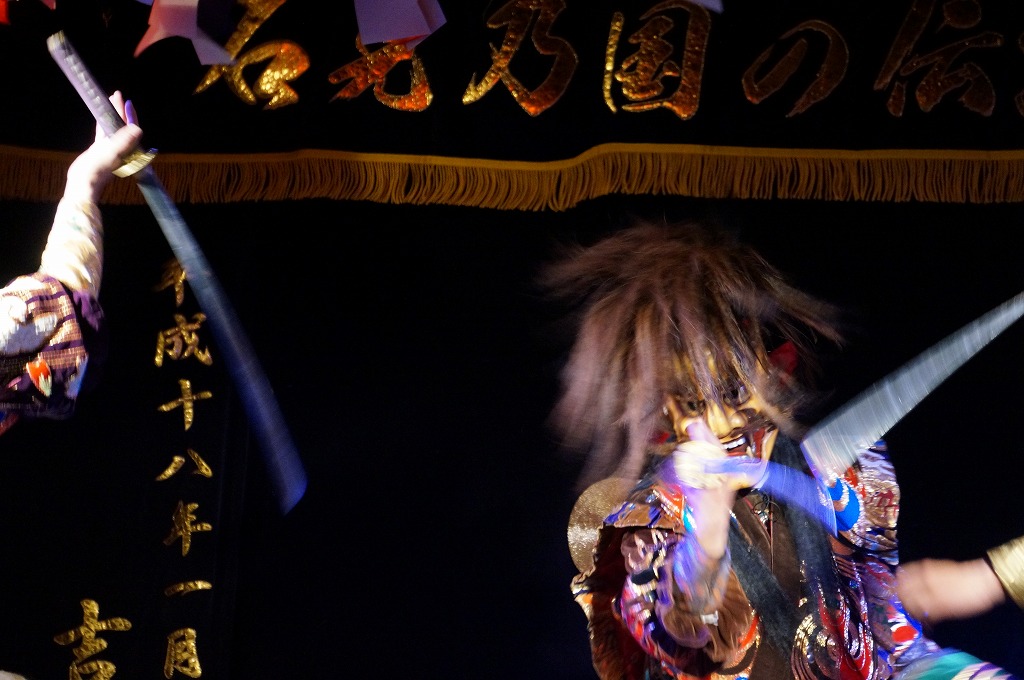
First comes Michizane and his subordinates. Michizane states, “I am going to appeal to the gods for my innocence. The subordinate stops him from going alone. He says, “I will go with you.” Then, the villain, in this case Fujiwara no Tokihira, appeared with suspicious smoke. But here’s a further twist. Another mask appeared from underneath the mask, showing that the Demon King had actually taken over Tokihira. The battle of two against one begins. Intense, tireless movement. After the short break performance, it was very refreshing.
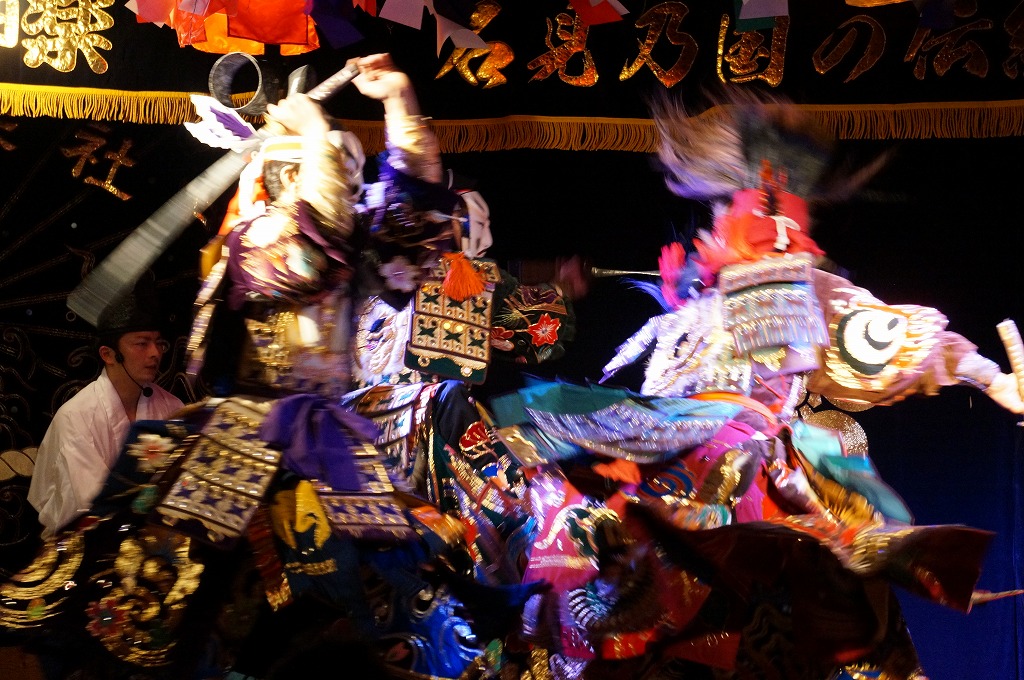
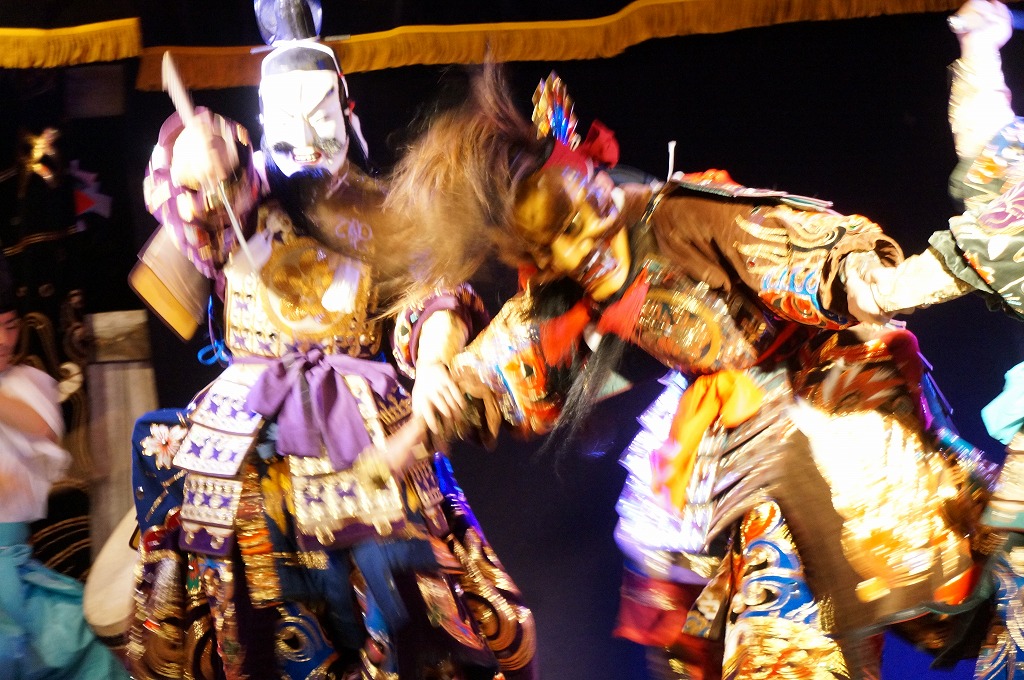
Jinlin 塵輪

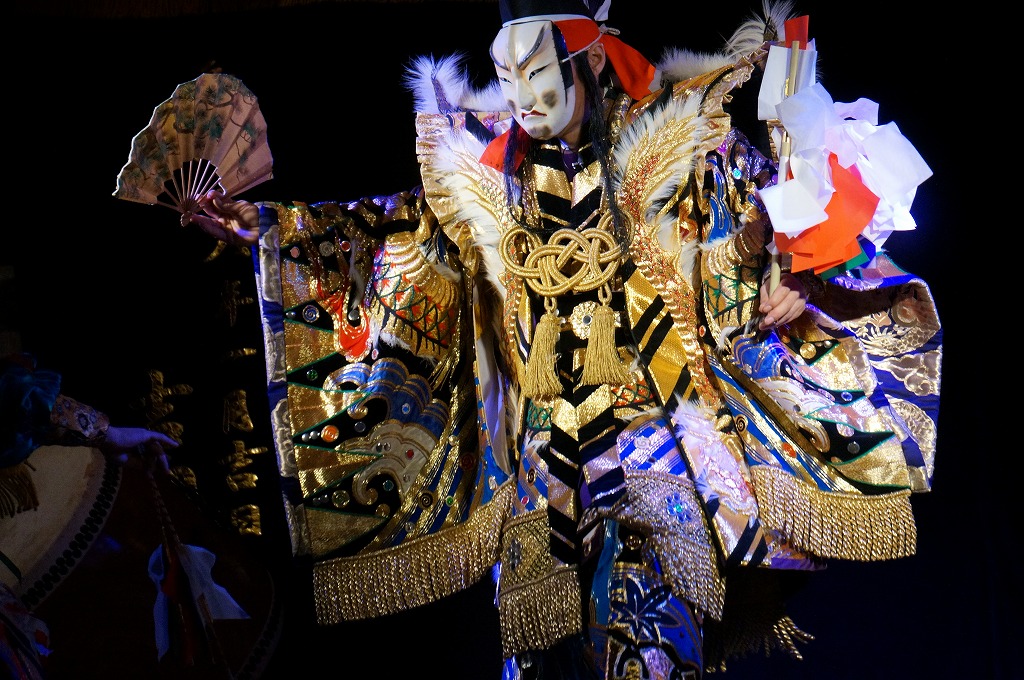
This is another representative performance of Iwami Kagura. The two good guys and the two bad demons. The protagonist is Emperor Chuai 仲哀. He is a real person. He is described as the 14th emperor in the Japanese official history books. However, he has no particular achievements. His father is a hero named Yamato Takeru, and his wife is also a famous person. And yet, his presence in the book is extremely weak. In the first place, there are many scholars who doubt the very existence of the old age. So the fantasy elements are stronger. The appearance of his subordinate, Takamaro, followed by the appearance of Emperor Chuai. There are elaborate samurai dolls in Japan which parents mainly displayed to wish for the growth of their boys. A fantastic sight appeared in front of us, as if the dolls themselves were walking around. I think this is the essence of Iwami Kagura. Regardless of the history, Emperor Chuai is a hero here. Realism is not necessary for fantasy. A puppet-like hero defeats the bad demons. I could see things that only happen in cartoons and games unfold before my eyes. No, it’s as if we’ve somehow entered the game. That’s why children wield swords and learn difficult dialogues so easily. In fact, Kagura’s dialogues are difficult for adults to understand even if they read the script. Words that are not used in daily life nowadays come out one after another. The author of the first mentioned book wrote that he was amazed to see how children could say the lines so easily. He has gone to the trouble of posting the original text and asking readers if they can read it. The villains are also brilliantly graceful. They say, “We will bring pestilence to this country and make the people suffer.
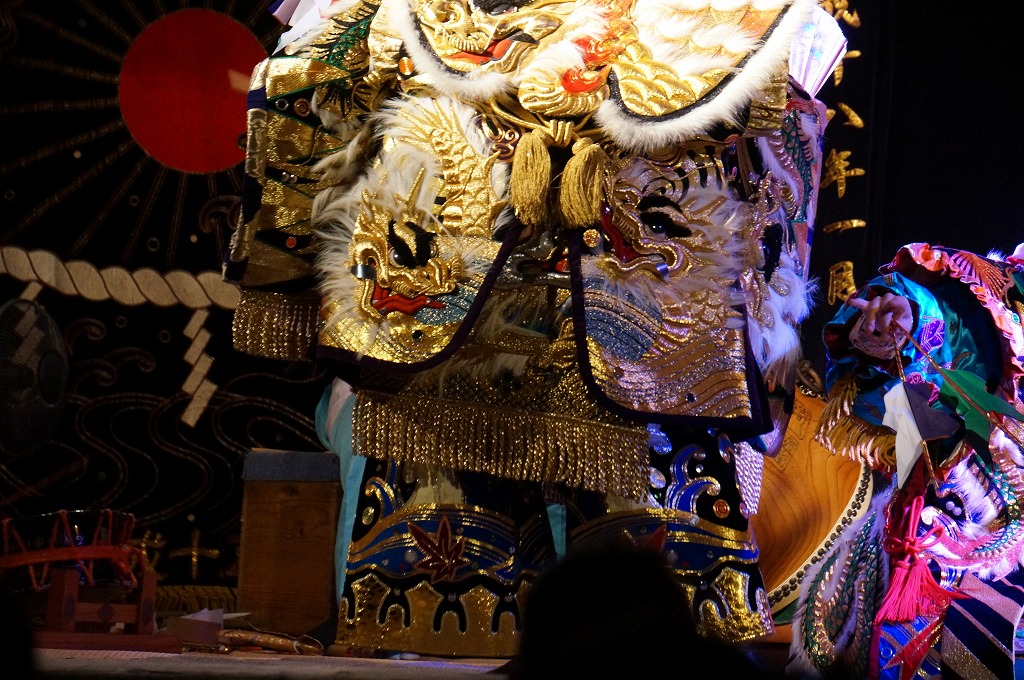

When I first saw the picture, I thought the masks of Iwami Kagura were vulgar. They certainly don’t have the delicate expressions of Noh masks. They are large in shape and have an easily recognizable expression. However, if you see them in person, you will understand. In this showy stage, something like a Noh mask would not stand out. You can see that it was inevitably created in this environment, on this stage, under this lighting, with this musical accompaniment.
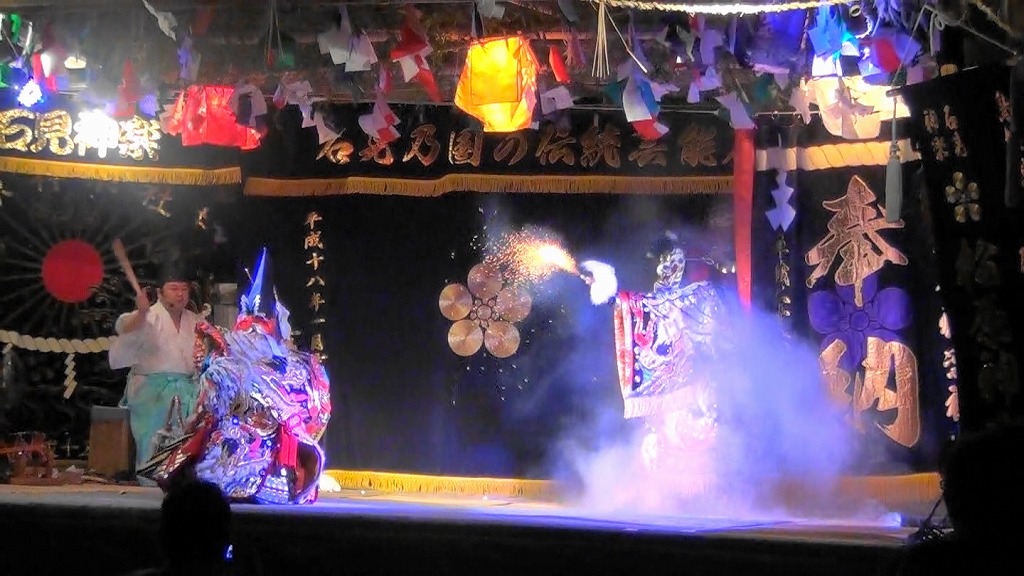
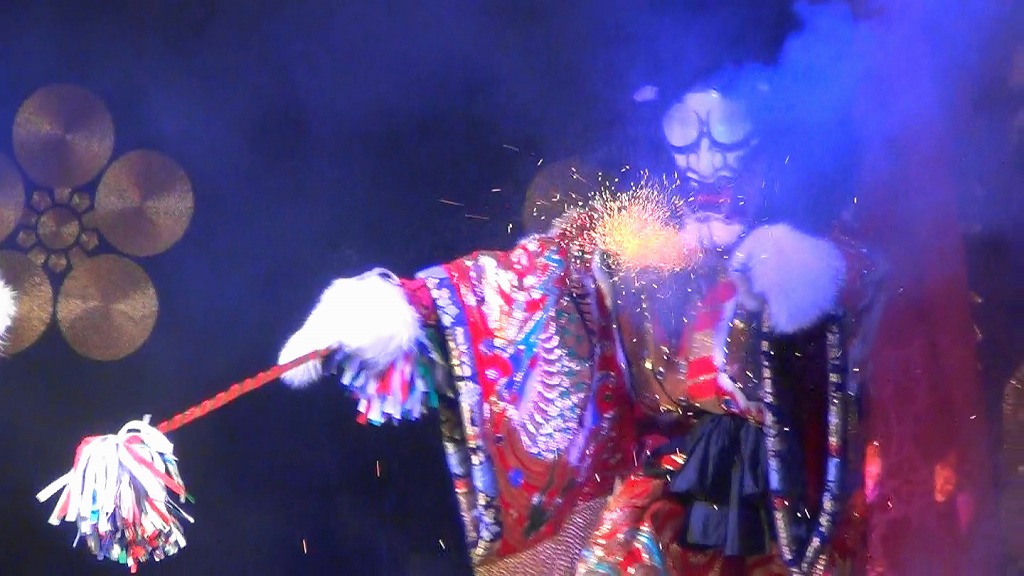
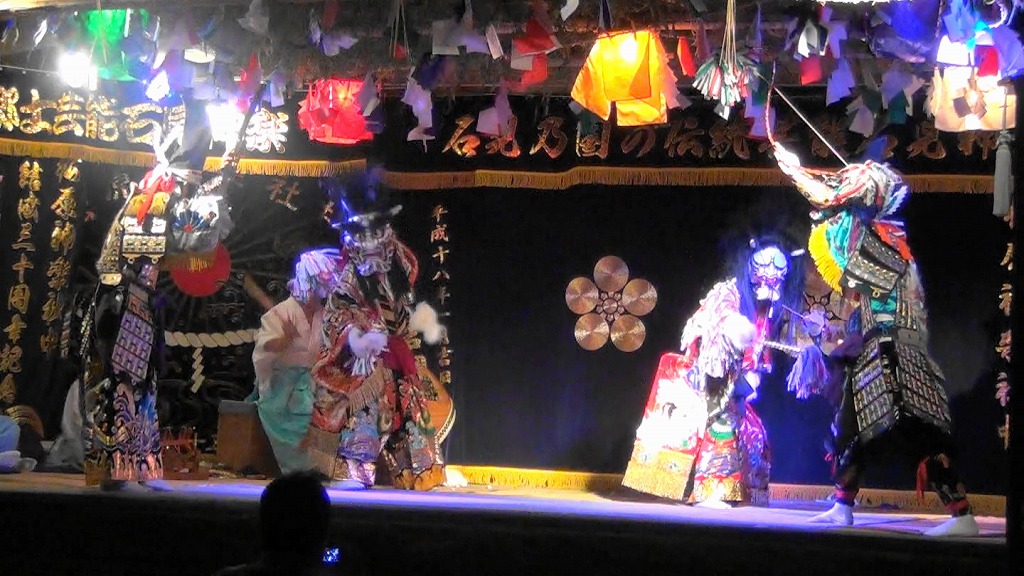
Demons spewed fire, swords were exchanged wildly and violently. The shouting echoes of the crowd were as exciting as ever. The taiko drum and the hand gong stirred up a sense of urgency at breakneck speed. There was no room for artistry there. Here is a form of traditional folk art that has evolved only for the purpose of entertaining people.
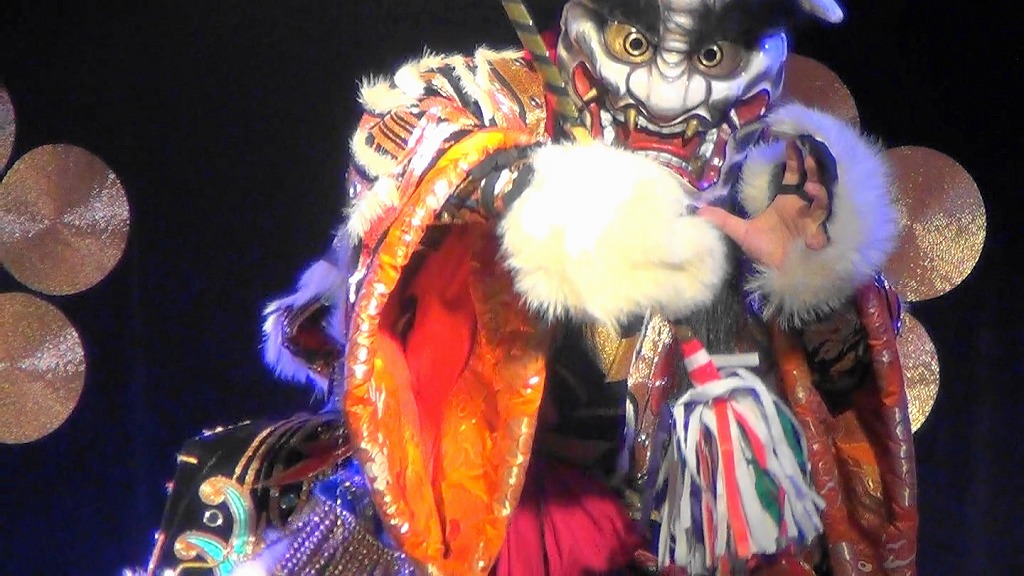
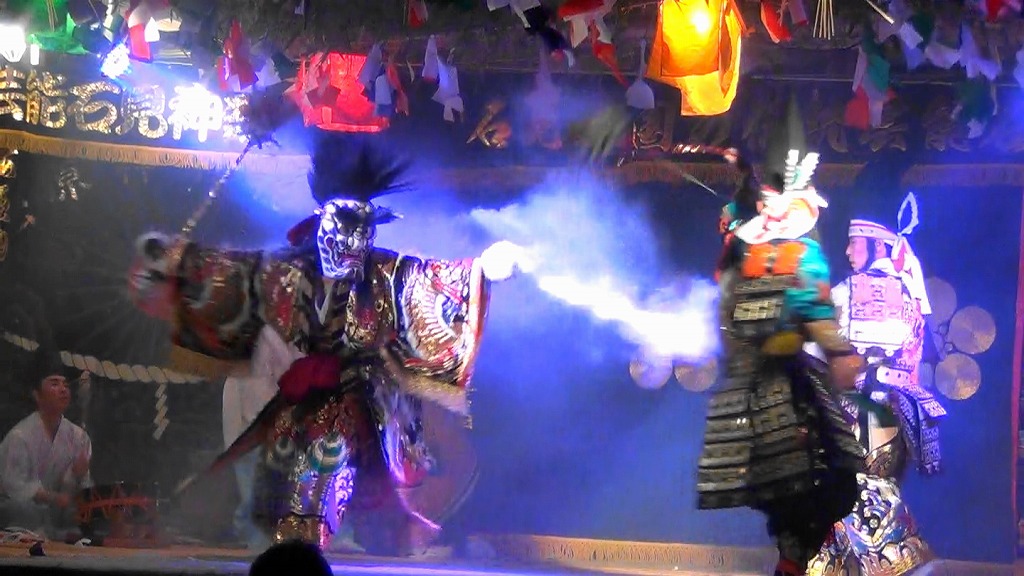
Yorimasa 頼政
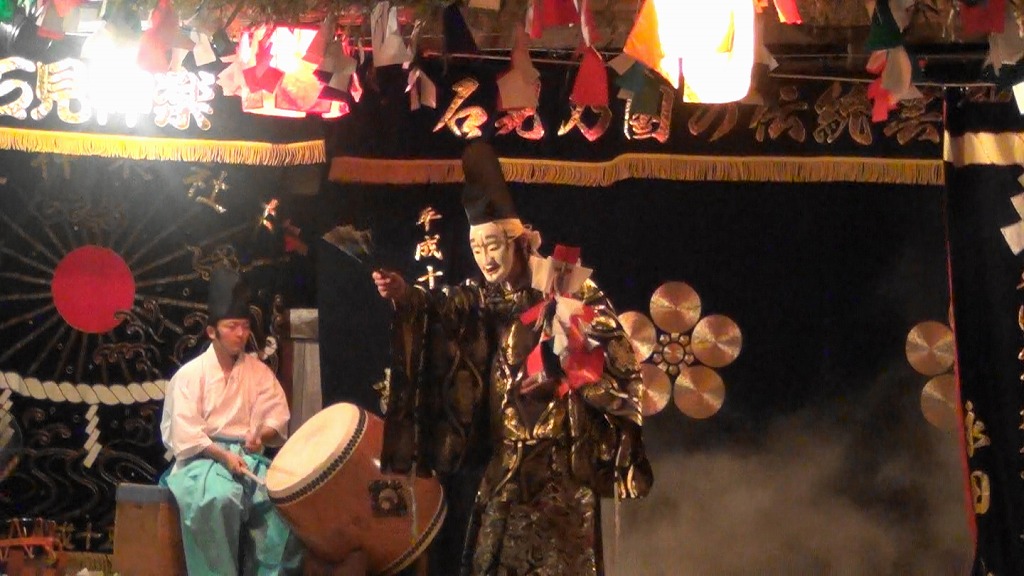
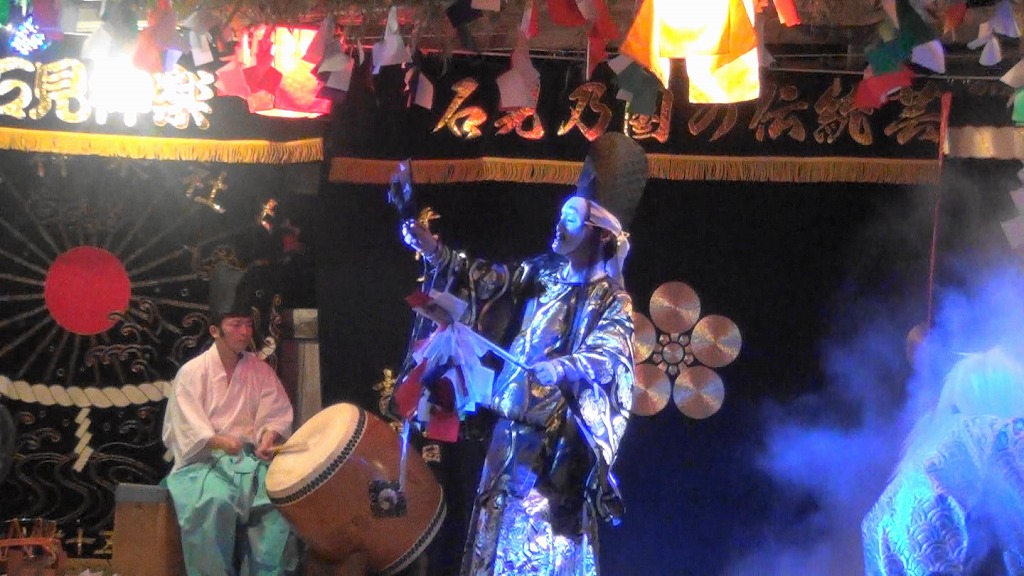
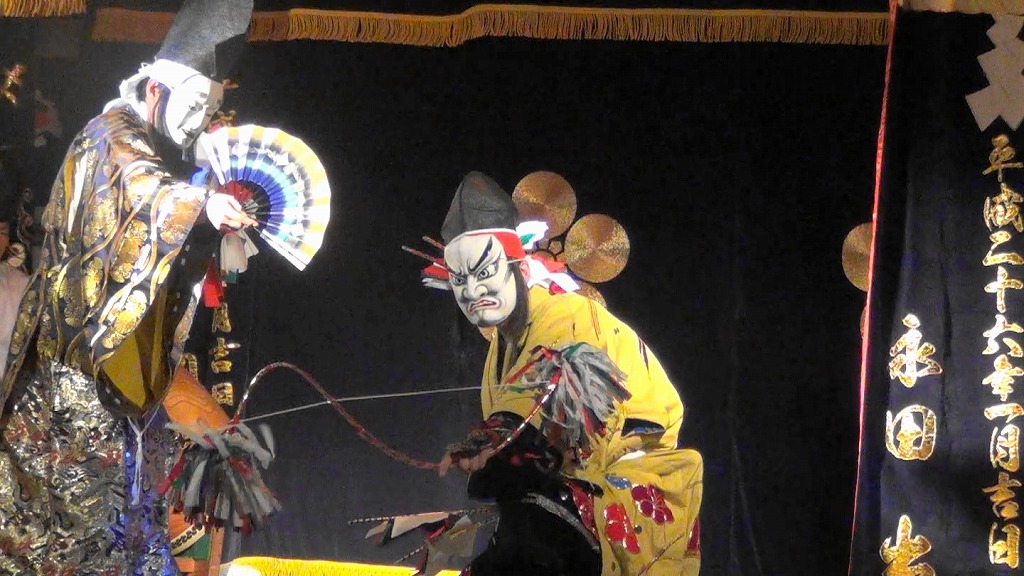
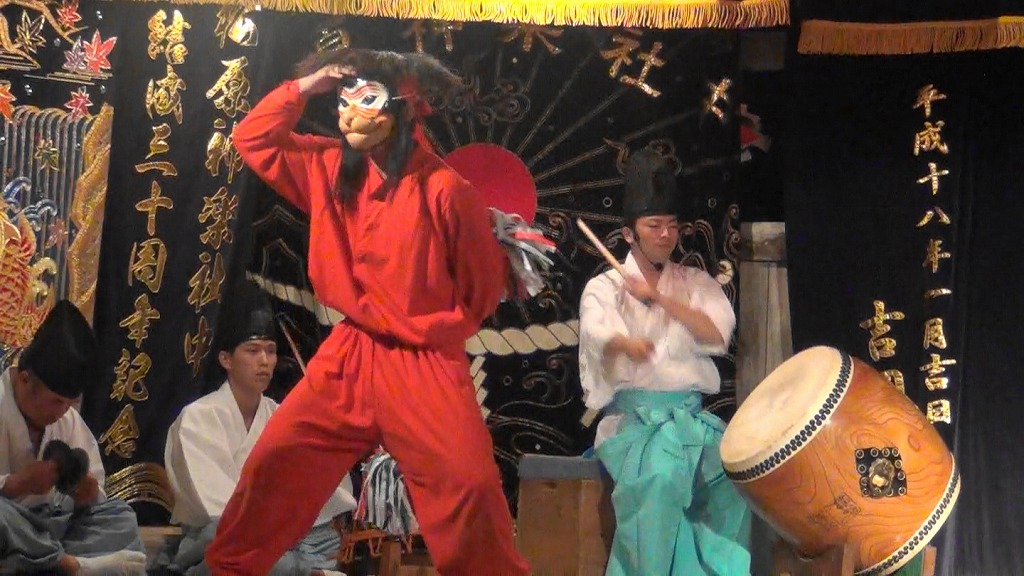
Before I knew it, it was half past two in the morning. Only four more to go. After all the fierce breathless fighting performance, it was time for the audience to get tired again.
Yorimasa is a real-life warlord. Here’s a little history lesson: In the early 12th century, the samurai emerged from a long period of aristocratic dominance. In the early 12th century, a long period of aristocratic dominance gave way to the rise of the samurai, who were under the rule of two warlords, the Taira 平 clan and the Minamoto 源 clan. The Taira clan was the first to come to power. However, those who were dissatisfied with the Taira clan called on the Minamoto clan to overthrow them. The first to stand up was Minamoto no Yorimasa. He had long sworn obedience to the Taira clan, so his rising shocked them. He was 77 years old.
This means that it actually has little to do with Kagura. Just think of it as the name of a single hero. However, Yorimasa’s defeat of the mythical creature, “Nue” is so famous that it is recorded in history books. It is based on this episode.
The story goes like this. The emperor Takakura tells Yorimasa, “Recently, because of the rampancy of Nue, the monster, the people in the capital are getting worried. Can’t you do something to exterminate it?” Yorimasa replied “I will get rid of them.” Yorimasa ducked for a moment. Then a monster appeared. With a mysterious smoke, it tries to attack the Emperor Takakura. Yorimasa rushes in just in time and chases the monster away.
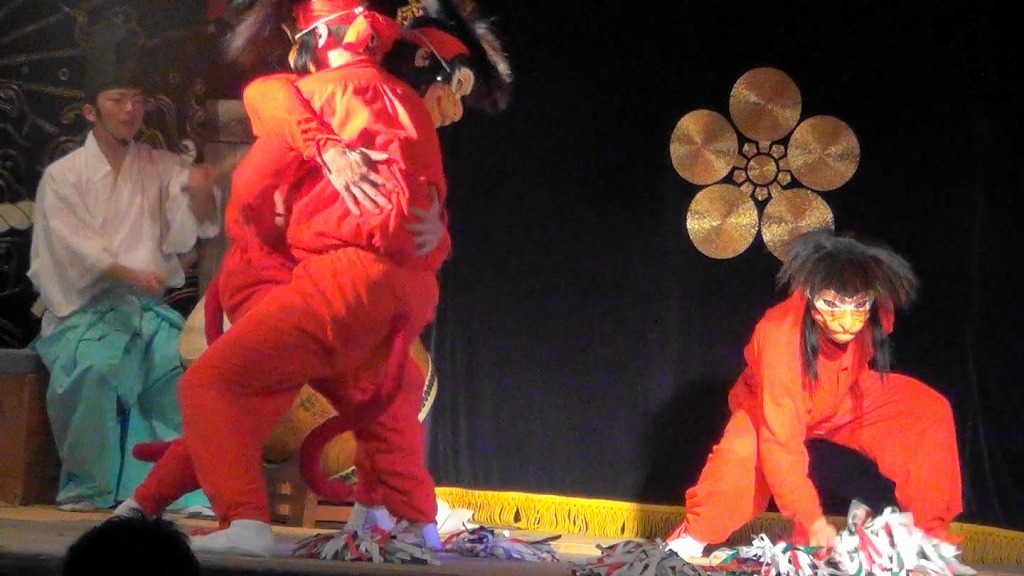
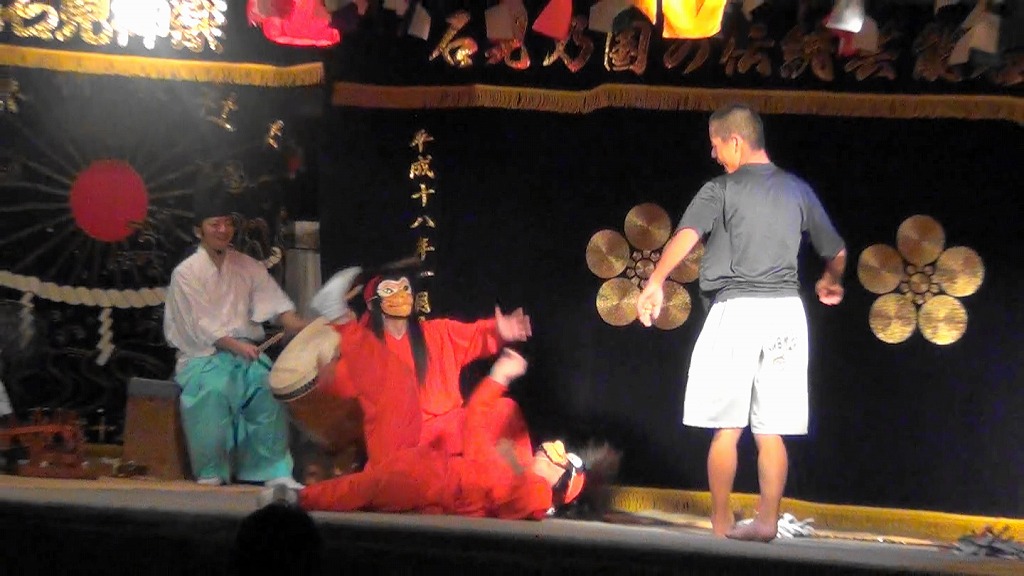
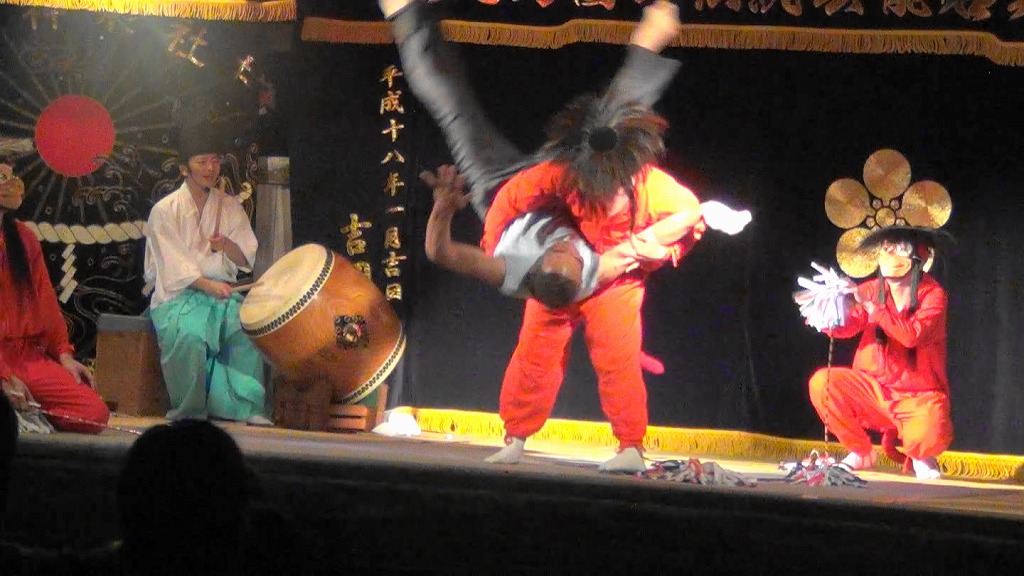
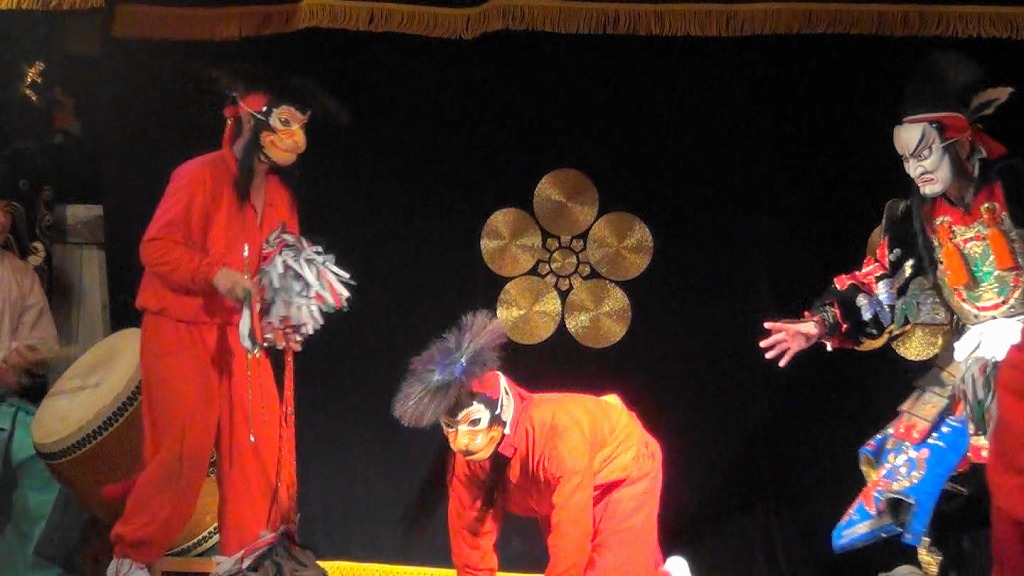
The scene changes and the monkeys with agile movement appear. Why are there monkeys? In fact, the Nue monster is said to have a monkey for a head, a raccoon for a body, a tiger for arms and legs, and a snake for a tail.
The monkeys begin to wrestle and play with each other. They bring children from the audience up to the stage and wrestle with them. A little relaxation time. The last person to come out was an older man. He looks like he’s drunk. A complete amateur but he was a resident of the kingdom of Kagura. His behavior was perfect as if he knew all about Kagura. The children were throwing the monkeys around. But at this point, the monkeys must have decided that this person was safe to throw. The man was tossed in the air with a joyful look. The kind of gradual and rapid movement is also very effective of Iwami kagura.
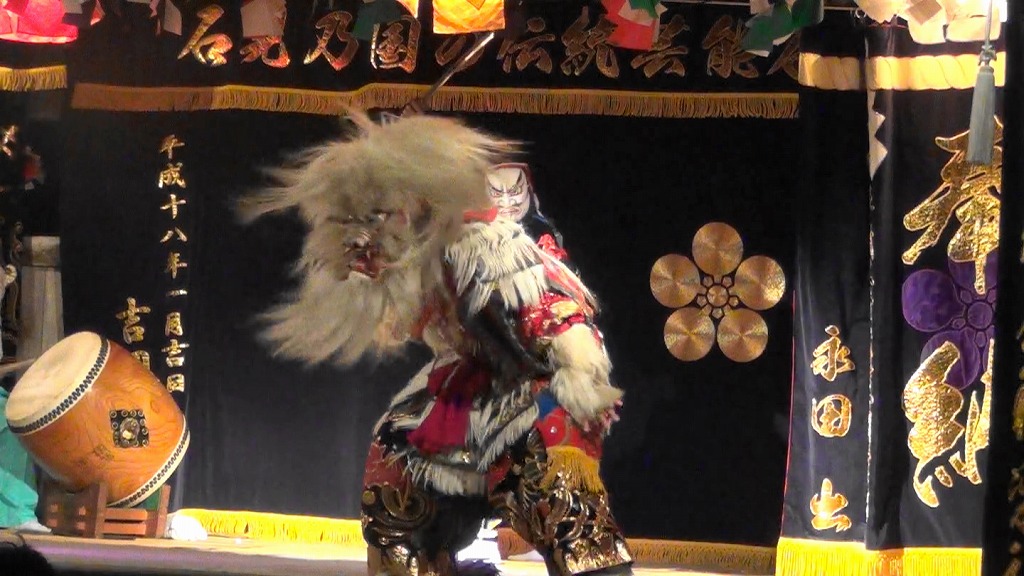
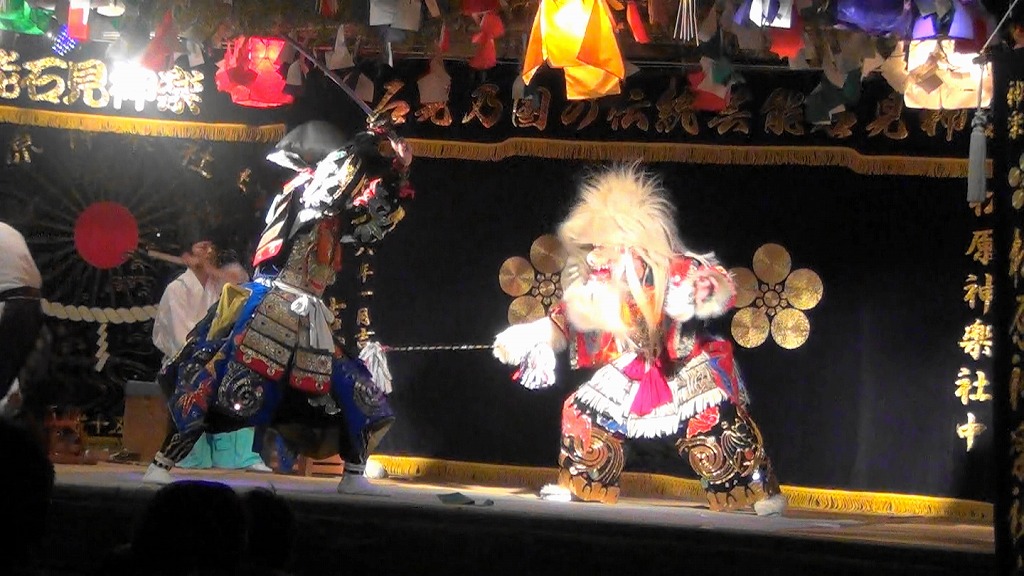
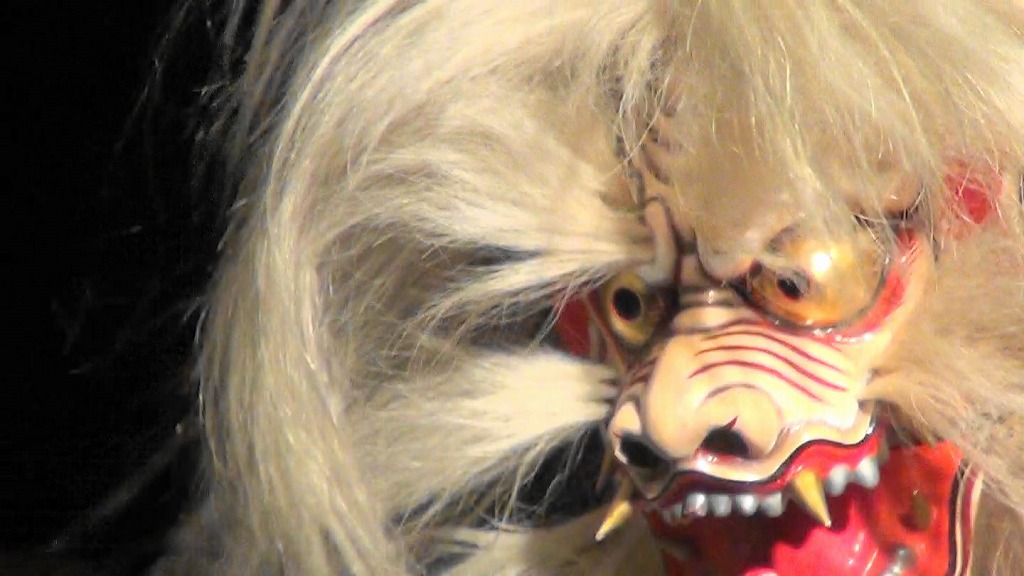
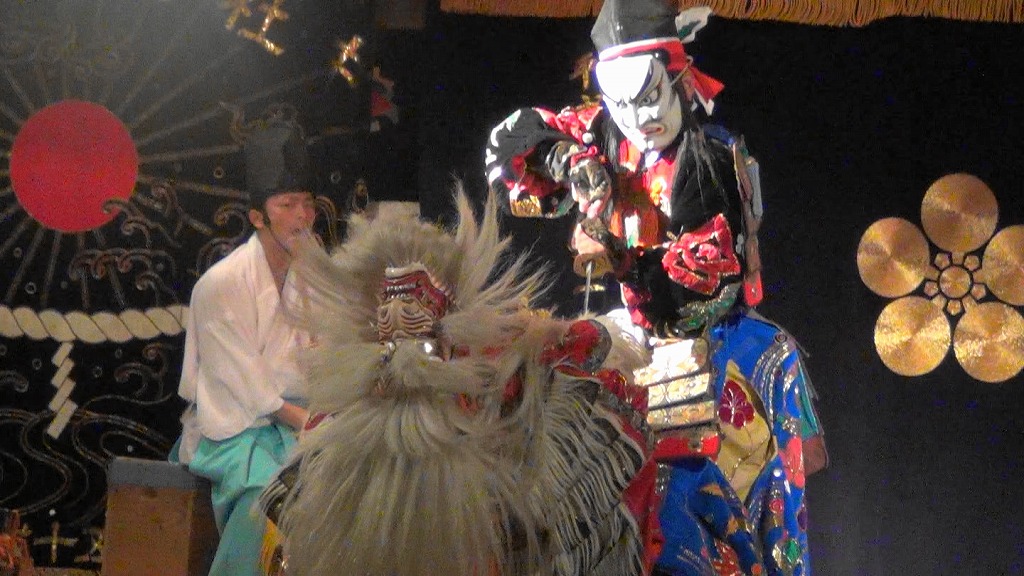
Here we return to the story. Yorimasa came and drove them out easily. This is where the enemy’s master, Nue comes in. The sideshow ended, and a violent spinning dance followed. Nue went out to the audience. Children scream and the audience’s sleepiness blown away. Before I knew it, it was half past two in the morning. Only four more to go. After all the fierce, breathless fighting performance. It was time for the audience to get tired again.
Shou-ki 鍾馗
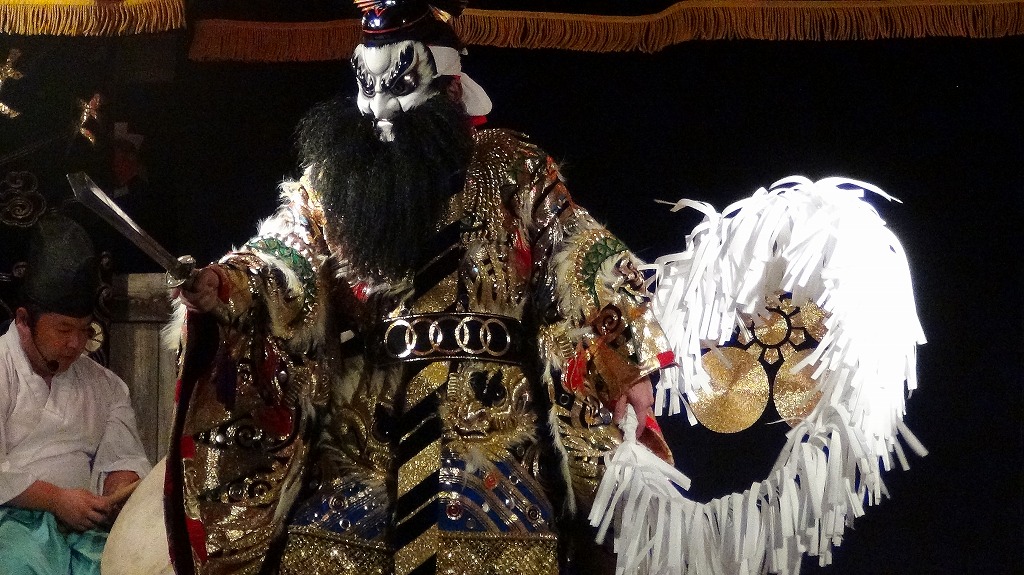
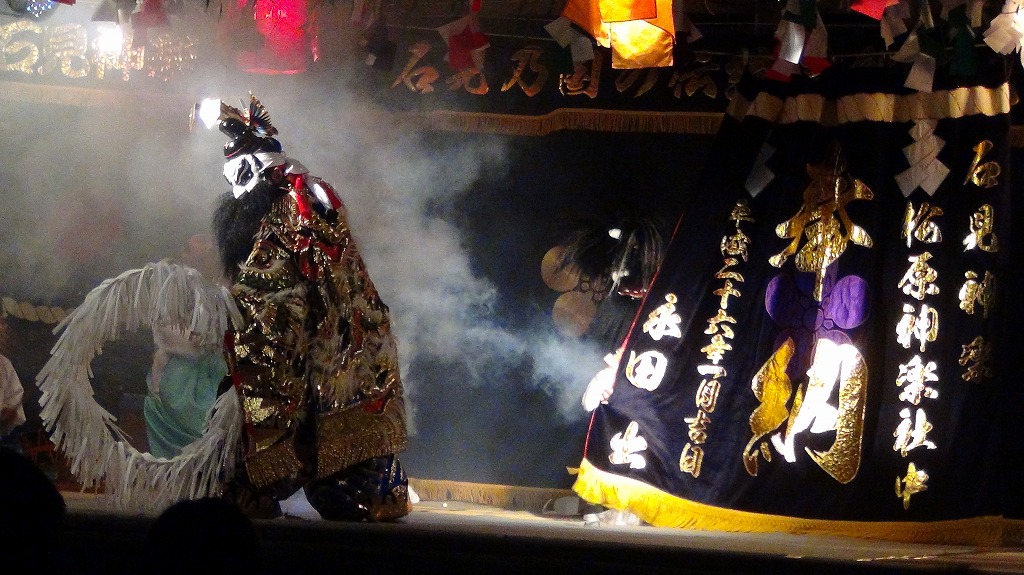
There are only three performances left.
“Shou-ki” is a Chinese hero. Legend has it that when the emperor was troubled by nightmares in the past, he appeared in a dream and conquered the disease.
“This performance, Shou-ki, is a very important program in Iwami kagura,” a member of kagura troupe told me. As he says, the dance is very prestigious. The dancers behave in a grave and dignified tone. In accordance with the original legend, the purpose of this dance is to pray for the disappearance of plague and safety in the home. For this reason, they use the most expensive costumes, and the actors are usually veterans. Perhaps that’s why he carries not only a sword but also a chinowa 茅の輪, a ring that seals out evil. Moreover, Shou-ki doesn’t kill the demon, rather, he reforms him. The end was also noble and lofty.
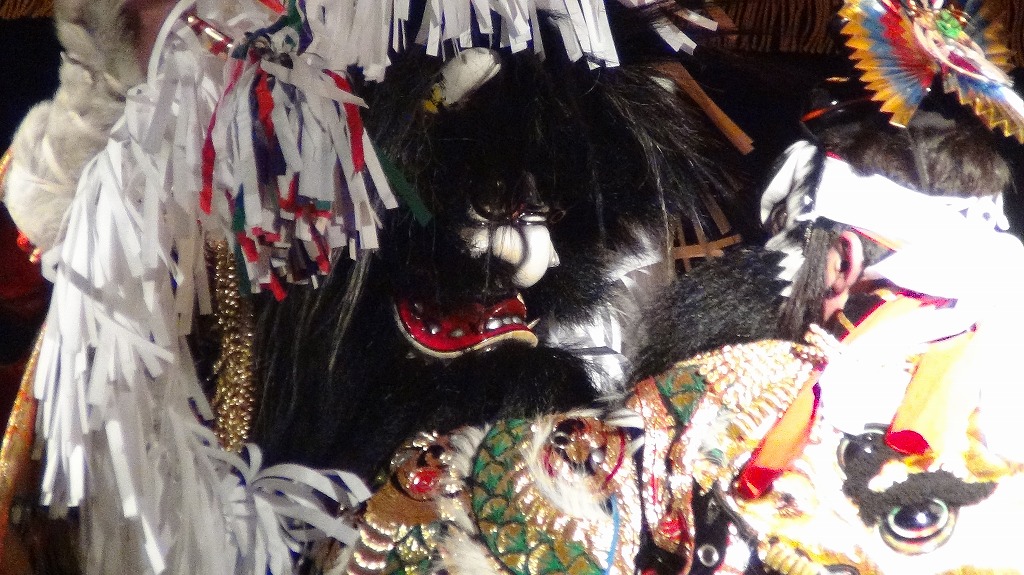

Ju-rasetsu-nyo 十羅刹女
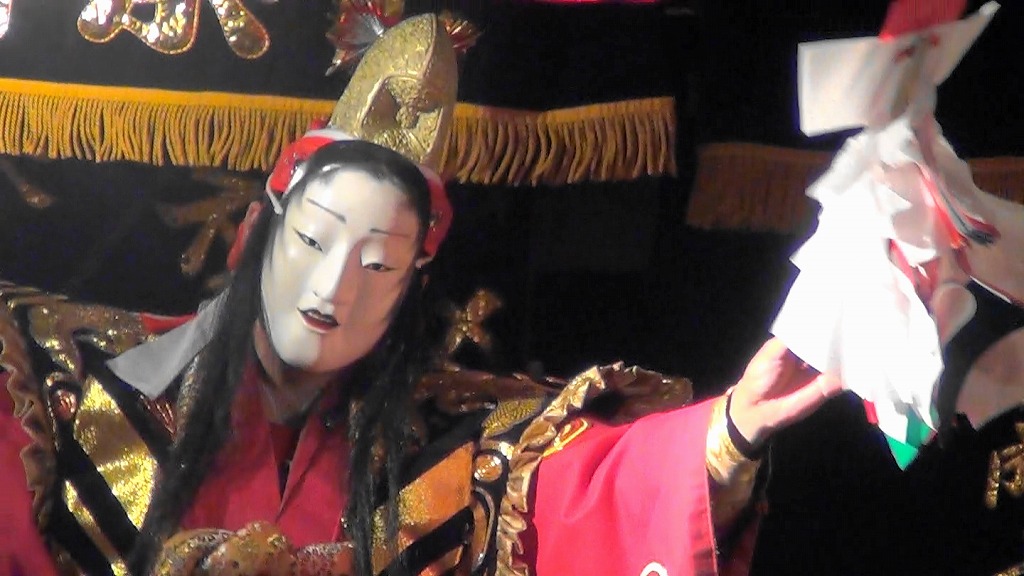
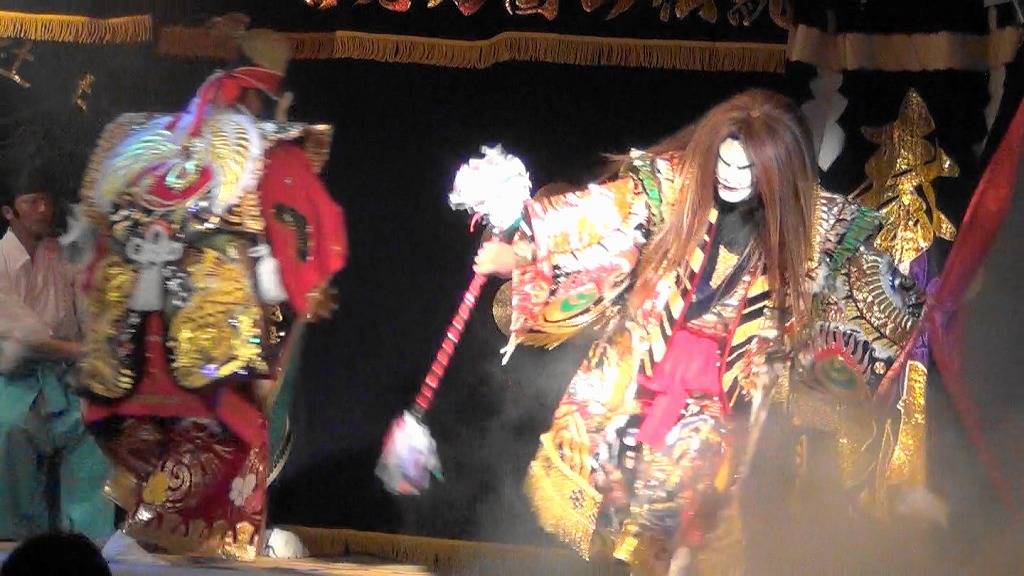
There were only two programs left. It’s 4:30 in the morning. The summer sky is already starting to brighten.
This program has a little different taste and hue from other programs again. The protagonist is woman. She is not just a woman. She used to be demoness who took advantage of her great beauty to steal spirits of humans. However she was exposed to the teaching of Buddhism and she transformed herself and became a guardian of Buddhism. Therefore, her mask is not that of one just like a pretty princess, but that of a strong-willed woman. Naturally, the antagonist is also female. An actor uses Hannya 般若 (cf.→https://discoverdeeperjapan.com/2020/06/07/the-most-detailed-japanese-traditional-mask/)type mask looking cold hearted. Of course, actors are wearing a mask, so we cannot tell whether actors are male or female. Nevertheless, by wearing a mask, we are able to enter a weird and fantastic world that is not of this world. However, even at this hour, the dance was still intense and the speed had not diminished in the slightest. Not only that, but the villain changed costumes, masks, and even hair color in the middle of the performance.
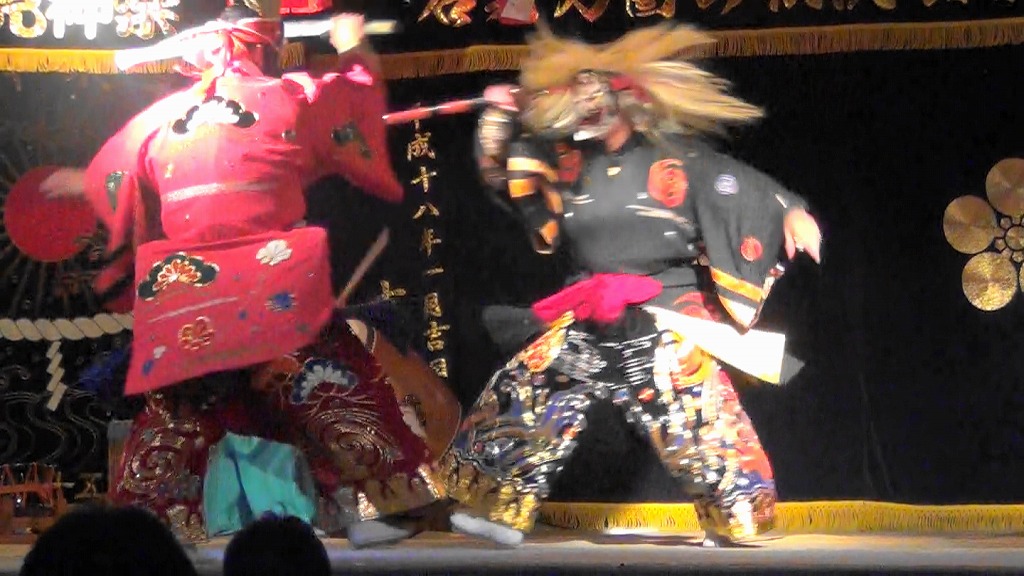
Orochi 大蛇 ~the essence of Iwami Kagura
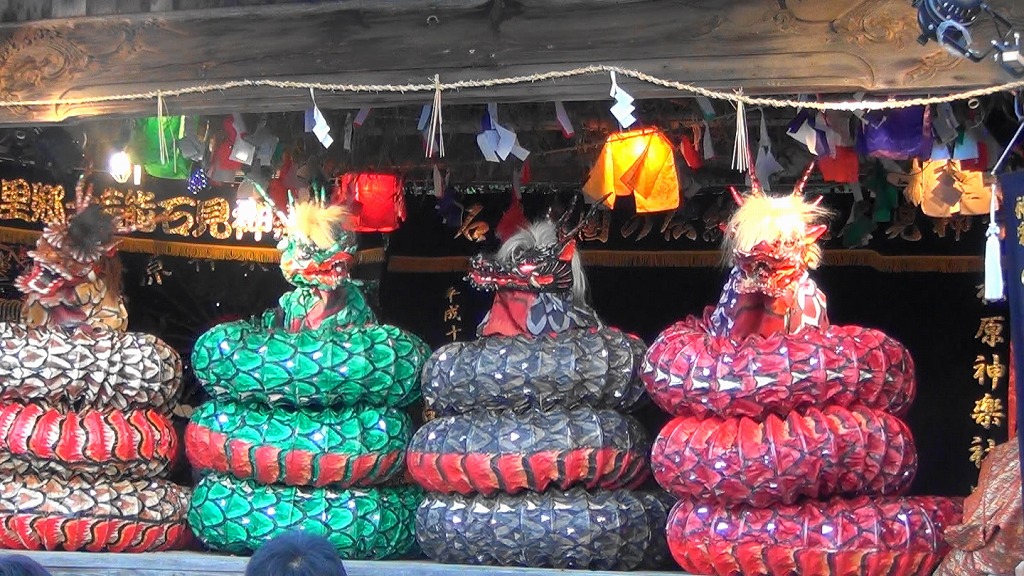
You can also watch the following you tube video →Part 1: https://youtu.be/D1NFWrmHLIE
part 2: https://youtu.be/KhIHAGORB9A
Part 3: https://youtu.be/yKvTkFr9vzY
Part 4: https://youtu.be/4ZcYFtqfdXM
The extermination of Orochi is the most famous episode in Japanese mythology, along with the Opening of Iwato. (cf.→)
The story involves the rough and powerful deity, Susano being forced to leave the heavenly realm (Takamagaha高天原) due to a conflict with his sister Amaterasu, the main character of the Opening of Iwato), and bringing peace by defeating a terrible monster at Izumo 出雲. This program is the performance to summarize all of Iwami Kagura, and it would not be wrong to say that this performance is essence of creative ingenuity and originality with which Iwami Kagura has developed.
The story goes like this: Susano was forced to leave Takamagahara and wandered from place to place. And when he came to the banks of Hii 斐伊 river in the land of Izumo, he saw an old couple weeping in front of their young daughter. He asked “Why are you weeping?” They answered, “We had eight daughters. But a terrible monster called ‘Yamata-no Orochi’ (a serpent with eight heads) demanded sacrifice every year. And so far we have sacrificed seven of our daughters. And now, we have to offer our last daughter.” Susanoo heard this and asked about the monster’s characteristics. Susanoo was so rampant that he was driven out of Takamagahara. He asked. “If I kill the monster, will you give me your daughter?” “We don’t want our daughter to be killed any more. Please,” they replied. Susanoo heard that the monster liked to drink, so he ordered them to make a strong poisonous sake. Then, on the day of the visit, the monster came out and found that there was a large quantity of his favorite drink. He then left the daughter aside to be taken care of later and drank the sake first. Then, when the monster was drunk, Susanoo was able to easily swing Orochi around and successfully killed the monster. He married the daughter with great honor.
The festival venue was already beginning to brighten with the light of dawn. I’ve gotten used to the loud volume by now. The unique melody of Kagura has become familiar to me. Finally, expectation of seeing Orochi, the most attractive part of the show filled me up.

Why is Orochi considered representative of Iwami Kagura? That is accounted for its shape. First, the body. The body is called “Jado” (meaning the body of a snake). People use Japanese paper made in the Iwami region as a material to make them. They connect rings made of bamboo with washi. In this way, the body of the snake, which can expand and contract freely, is completed. The rest is up to the performers. Orochi was able to move its whole body with one manipulator. The key point is how to hide the performer’s appearance. In addition, the performers set fireworks in Jado’s mouth, and let them burst into flames as needed. This kind of ingenuity began in the Meiji era (1868-1912). The tone was changed from a slow six-tone to a fast eight-tone, the jado was further invented, and the costumes became more luxurious. The emphasis was on entertainment that was more in tune with the times.
First, an old couple (Ashinazuchi and Tenazuchi) and their two daughters appear. This is unusual. Normally, the story would begin with the crisis of the eighth daughter. However, the fact that there are two daughters means that one of them is the seventh daughter.
Why is there a seventh daughter?
Then Orochi, the star of the show, appears. This time there were four of them. This will affect the size of the area where the Kagura will be performed. In large venues, there can be as many as eight Orochi.

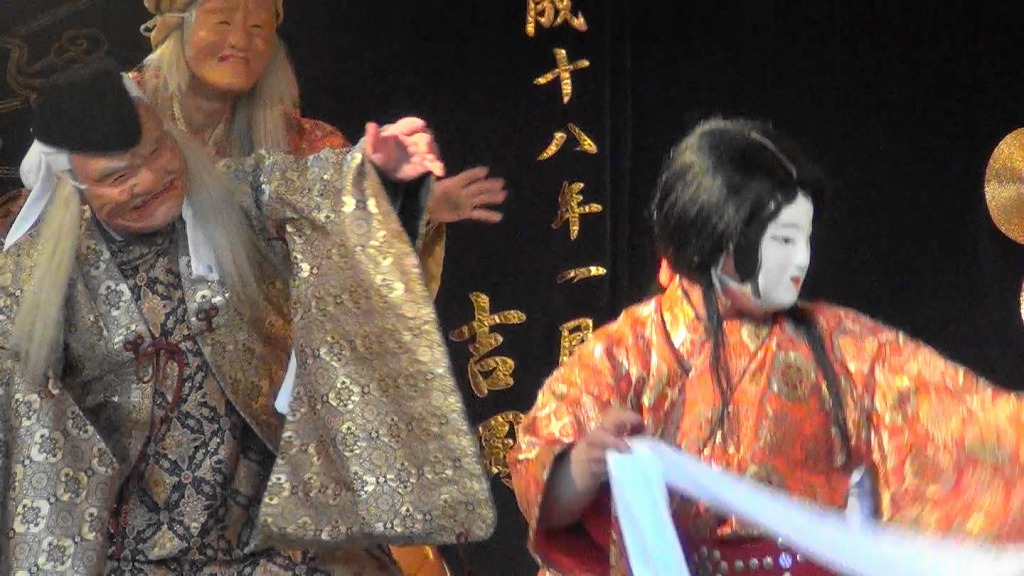
A weeping old couple and their eighth daughter (Kushii-inadahime). As if she has given up, the seventh daughter goes to Orochi. They pull the cloth together until the end. But Orochi is relentless, and devours her. Orochi wraps the daughter in his body. Eventually, the daughter disappears into Orochi. This is something you don’t usually see. This is only possible because the kagura is performed throughout the night, when there is plenty of time.
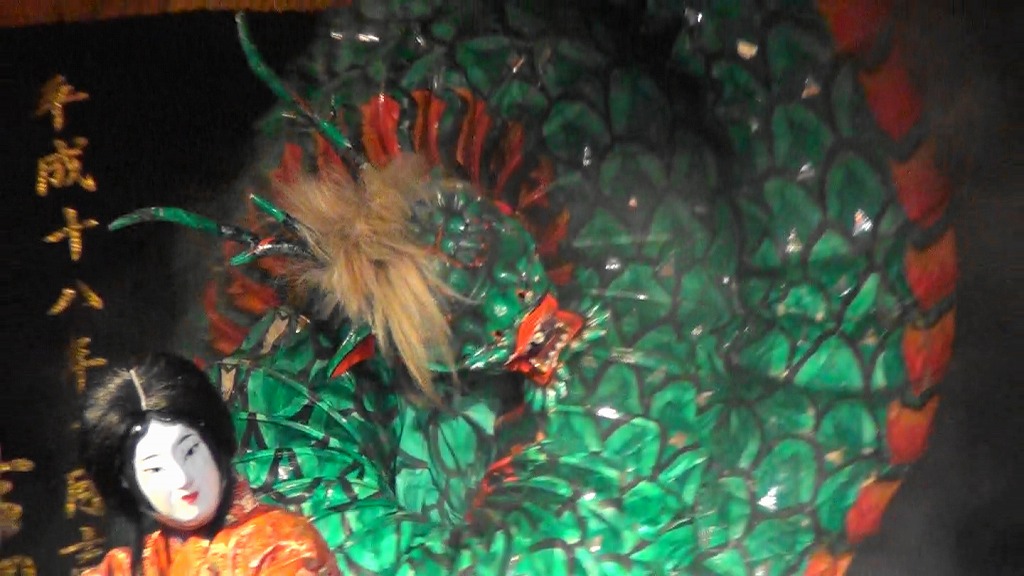
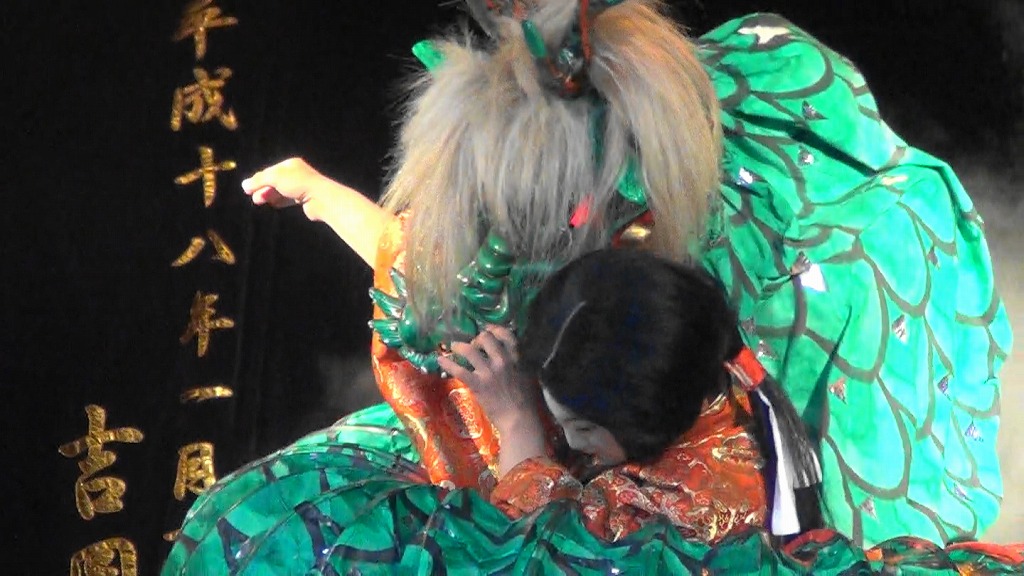
And finally, here comes Susanoo. He heard about the situation from the old couple. He declares that he will kill Orochi in exchange for taking the final daughter, Kushi-inadahime, as his wife.
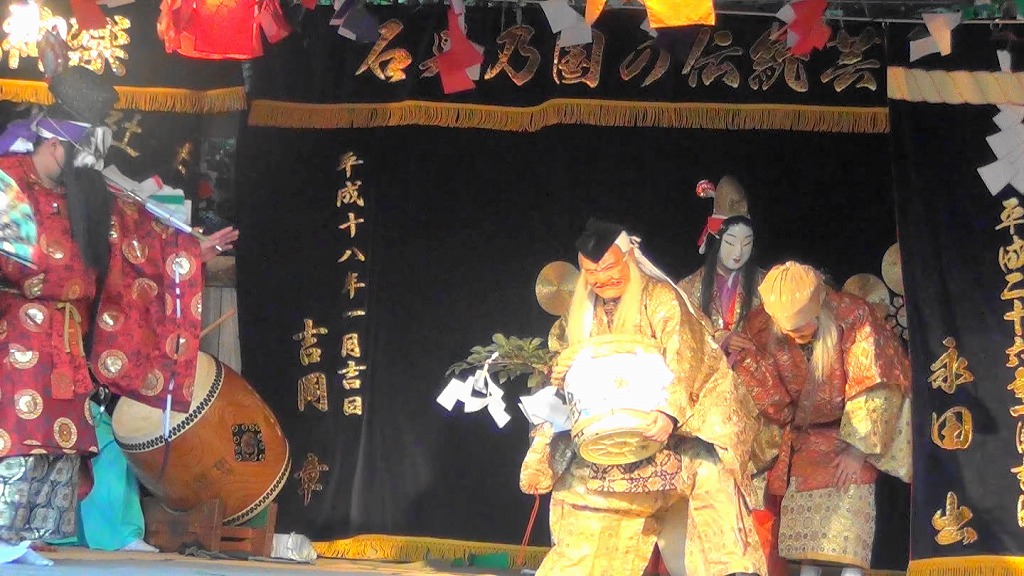
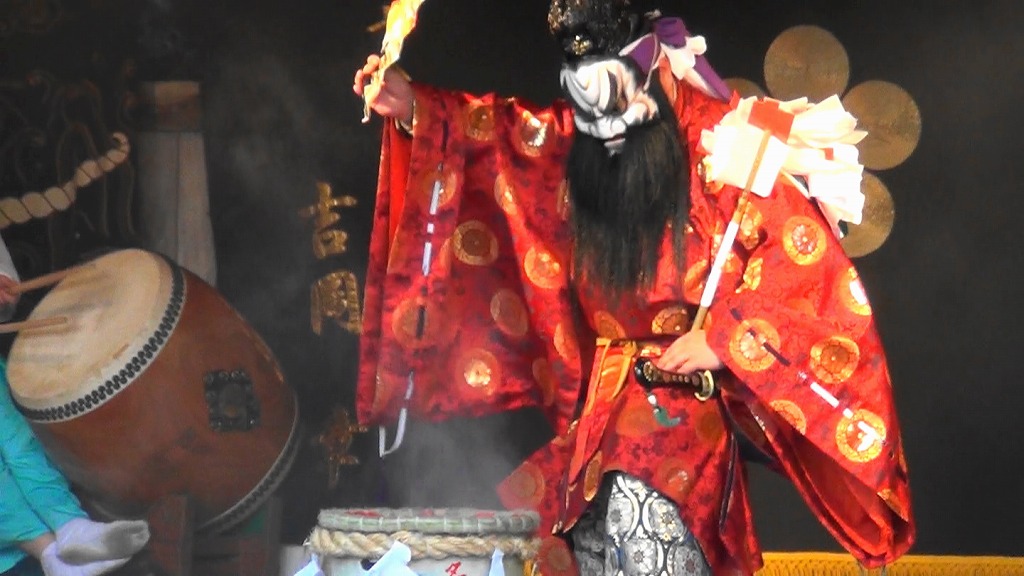
Once that’s decided, it’s time to make sake. They boiled and boiled until they had enough poison to paralyze Orochi. When the sake was ready, Susanoo ducked behind the curtain for a moment.
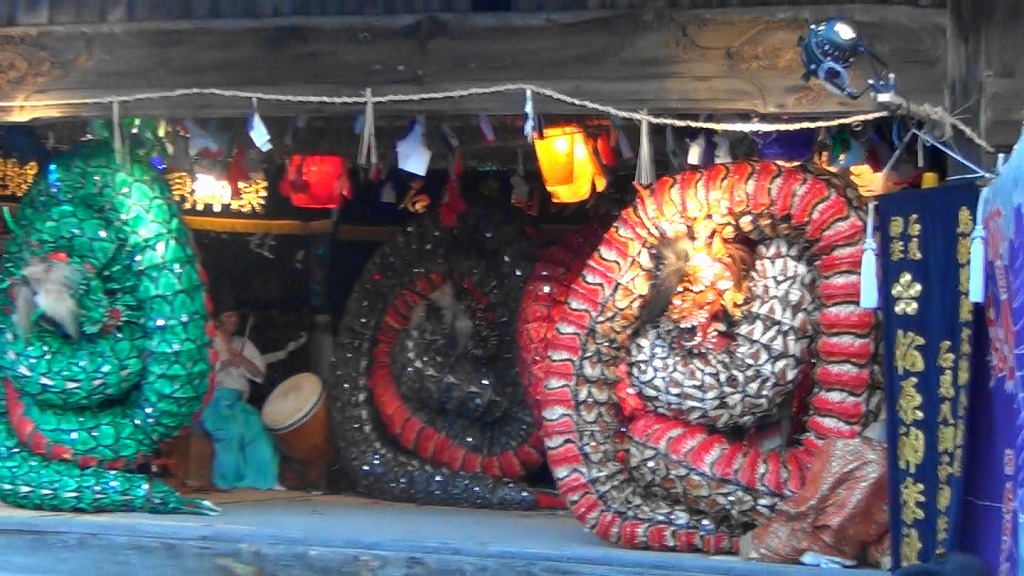
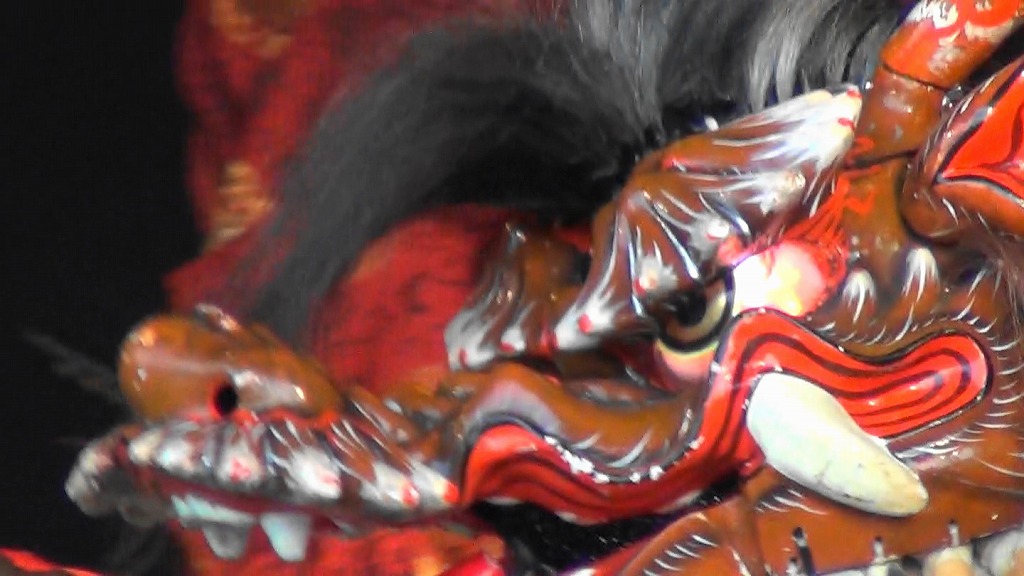
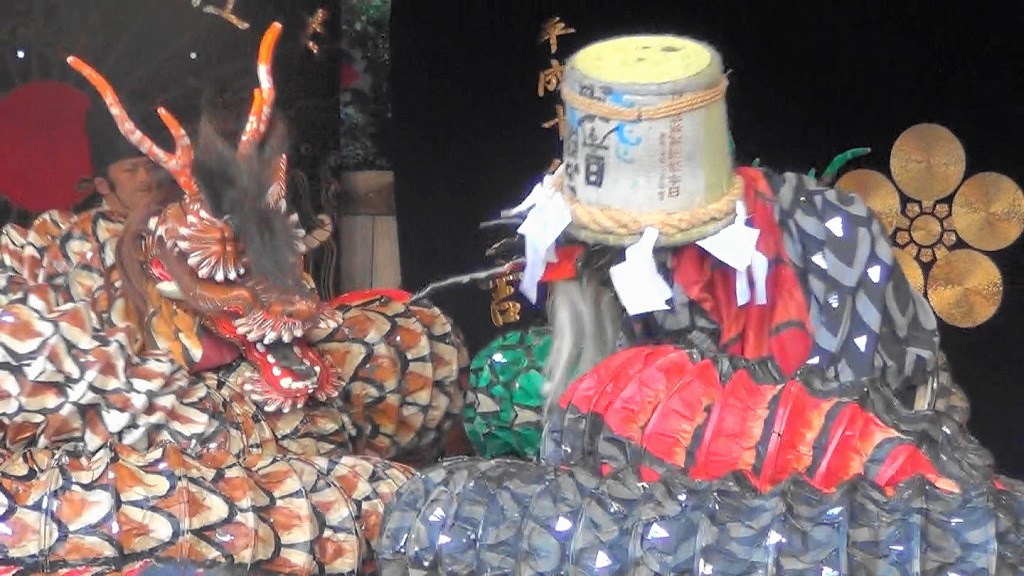
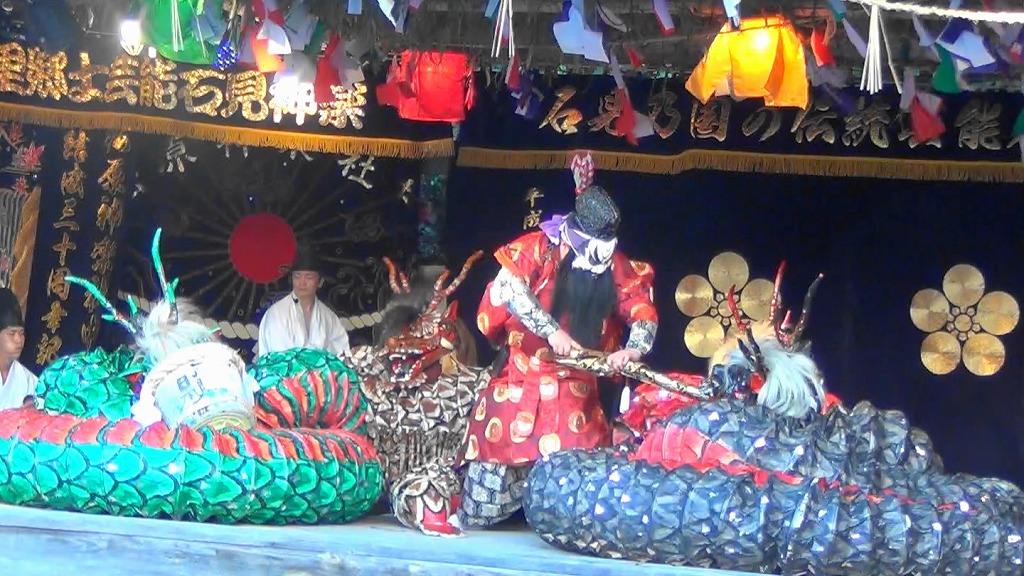
Orochi reappeared, and four of them performed a variety of tricks, including spinning spirals and blowing fire. When they eventually found the sake, the heads would fight each other eagerly to drink. Susanoo came out again slowly and quietly to watch Orochi.
Susanoo observed Orochi for a while. It would be easy to cut off Orochi’s head here. Of course, it’s not that easy.
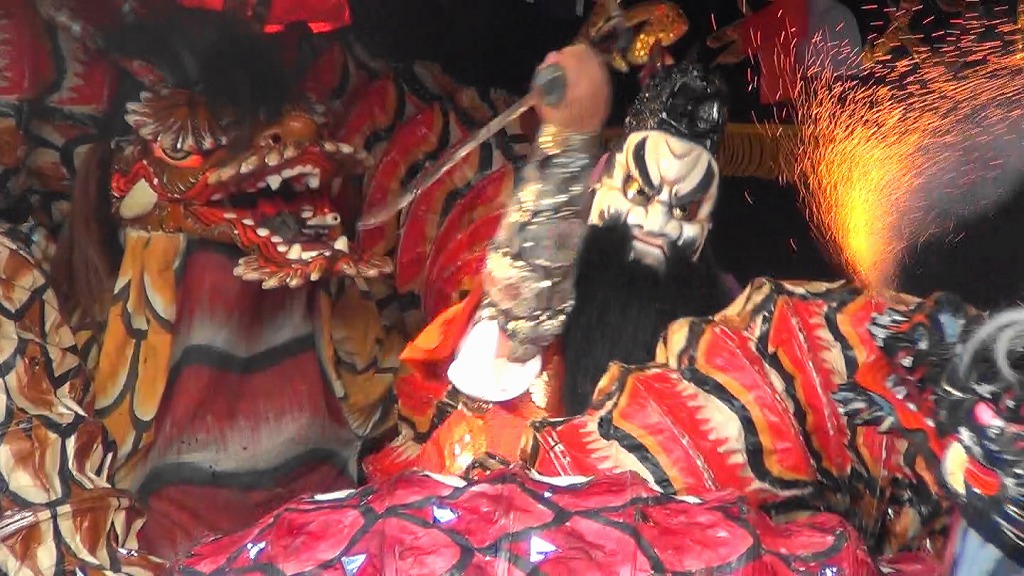
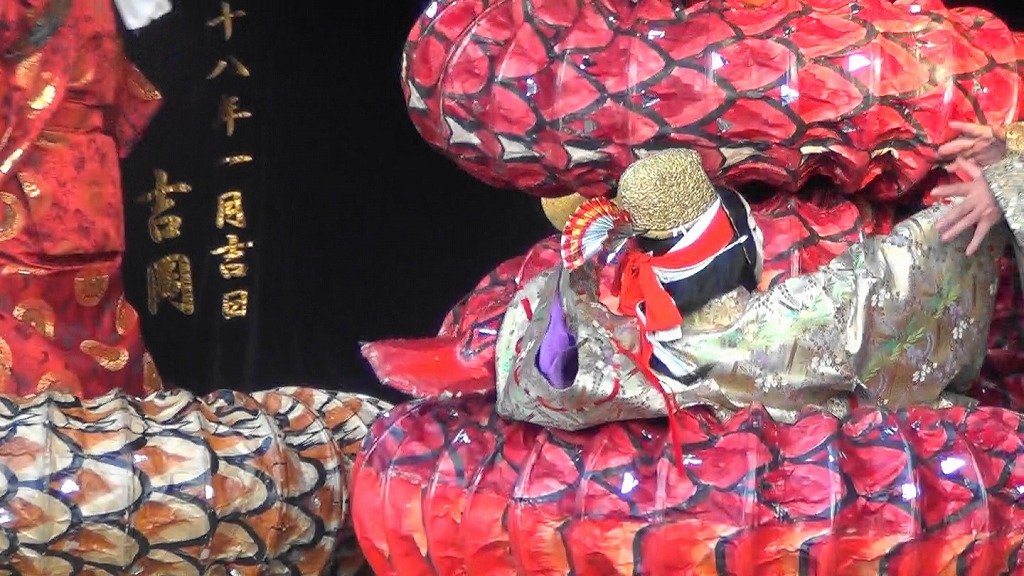

Orochi suddenly woke up and attacked Susanoo. Orochi coiled himself up and tied Susanoo up with his long body. Orochi blew out fire and strangled Susanoo, trying to devour him. Susanoo swung his sword and tried to cut off his head. He finally breaks free from his bonds. This time, however, Orochi tries to eat the princess first. Oh no, princess was in danger.
The music was playing like crazy, and the drummer was shouting “eisa, eisa” with his voice dry. The drummers had been beating the drums with their whole bodies for the whole night (even if they had to take turns). No, it wasn’t just the drummers. The entire Kagura troupe must have been exhausted. With the last of his strength, Susanoo pulled the Orochi’s body apart and cut off its head, one by one. I had already been watching it for hours. It’s the same story. It was as if I had just seen Iwami Kagura for the first time. I was both elated and fascinated.
After everything was over, the entire Kagura troupe all came out and greeted the audience. Thank you for staying with us for such a long time. That’s what they said. It was pitch black when I came, but the sky had already dawned completely blue. It was a little after 6 a.m. The long, long night was over.
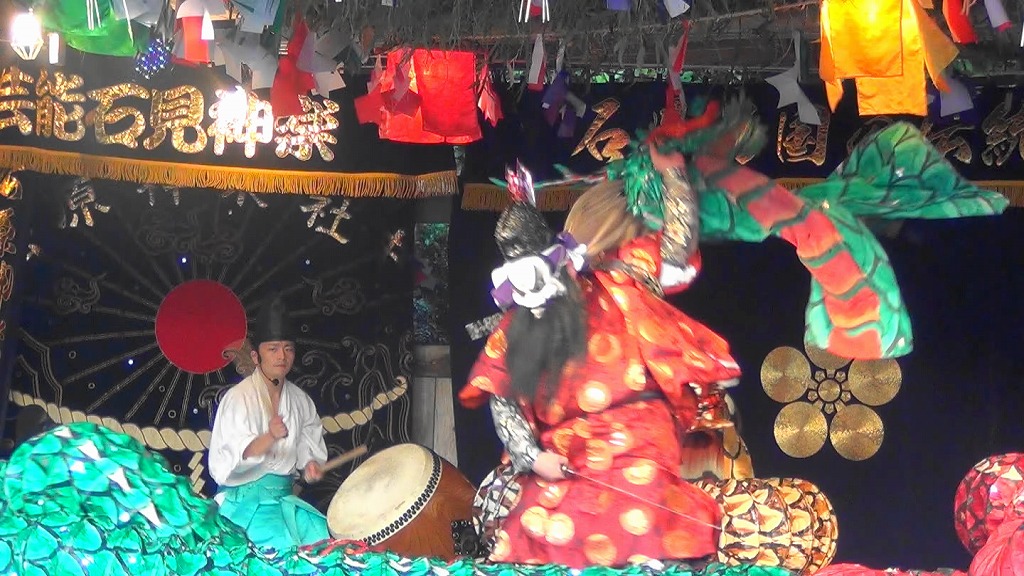
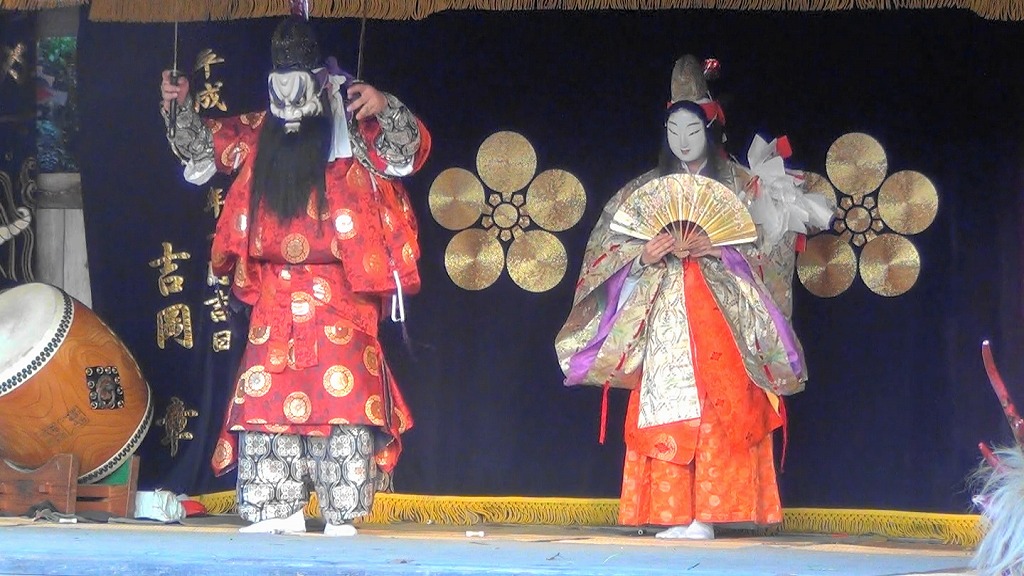
The road that had been so dark was now winding its way through the mountain village, bathed in the morning light. The demons and heroes had disappeared. Only the inside of my ears were filled with Kagura.